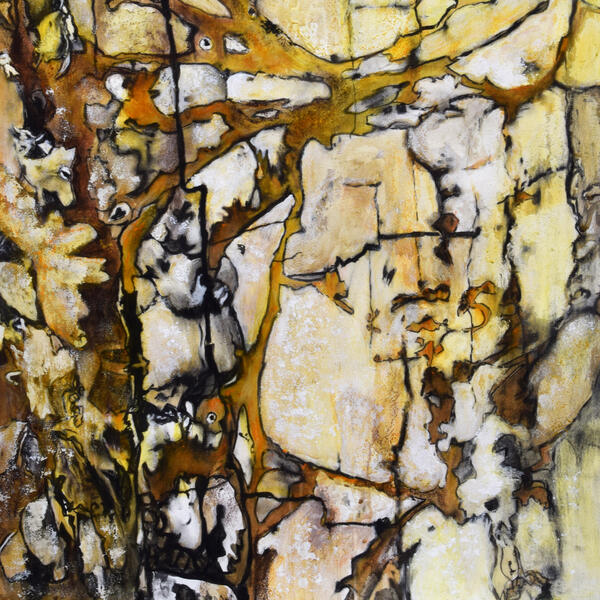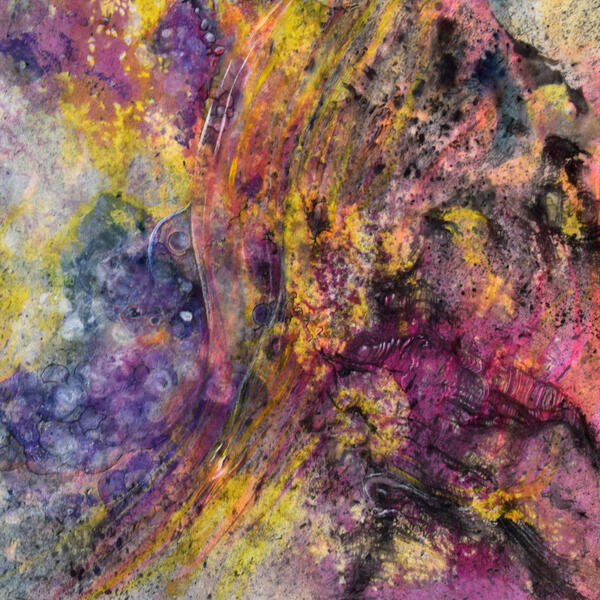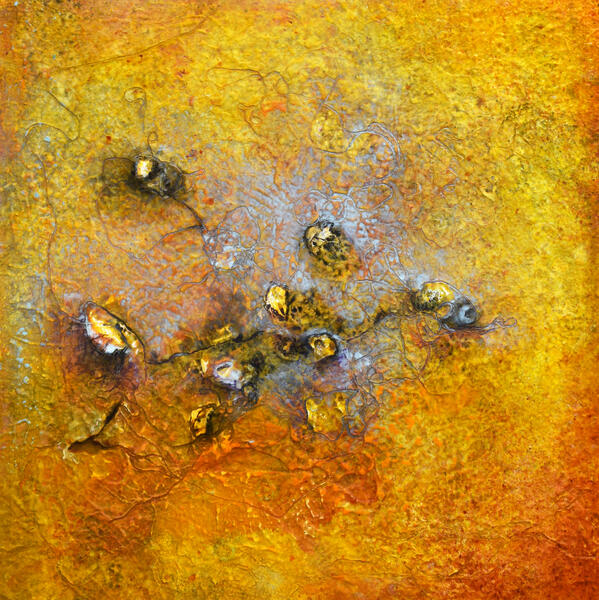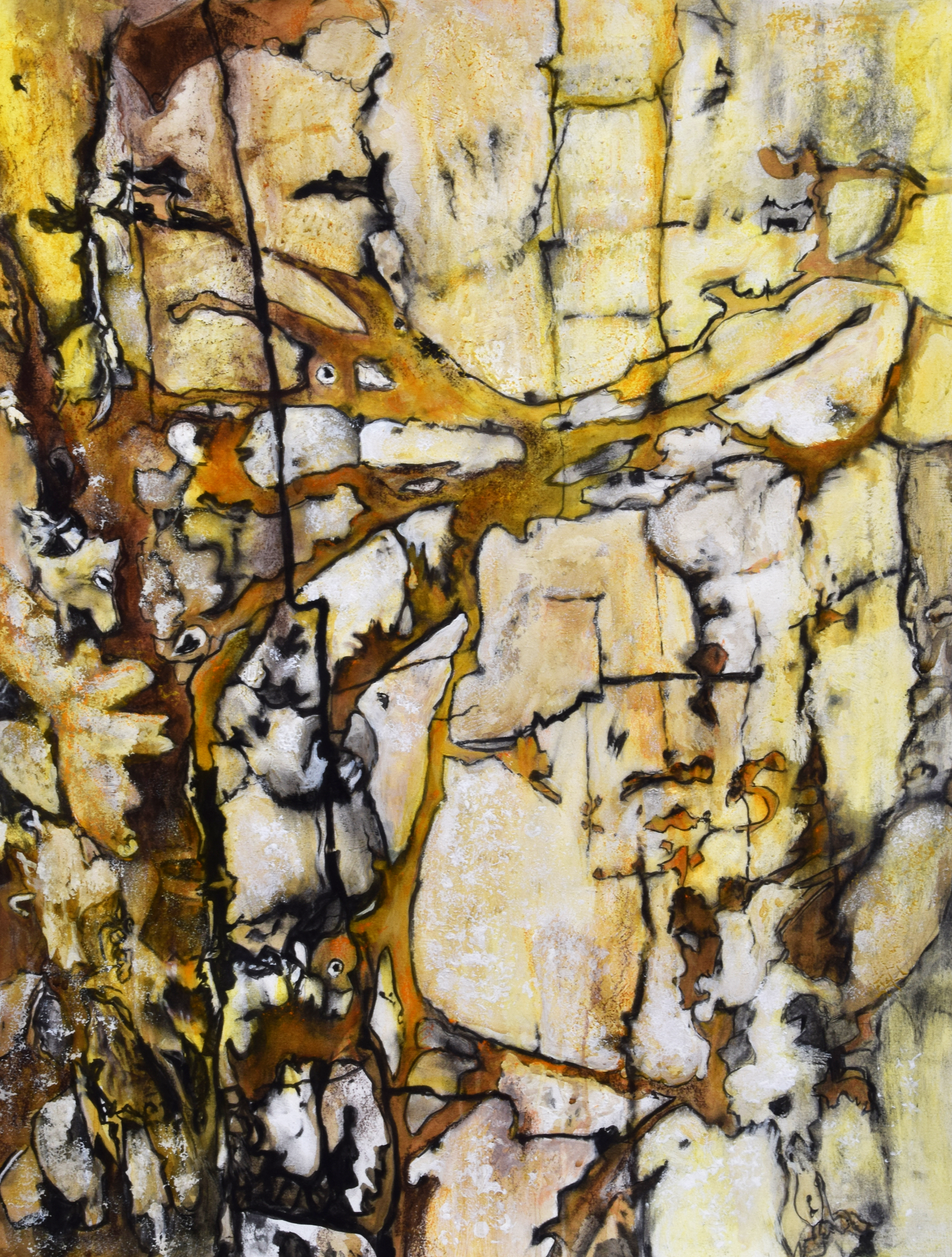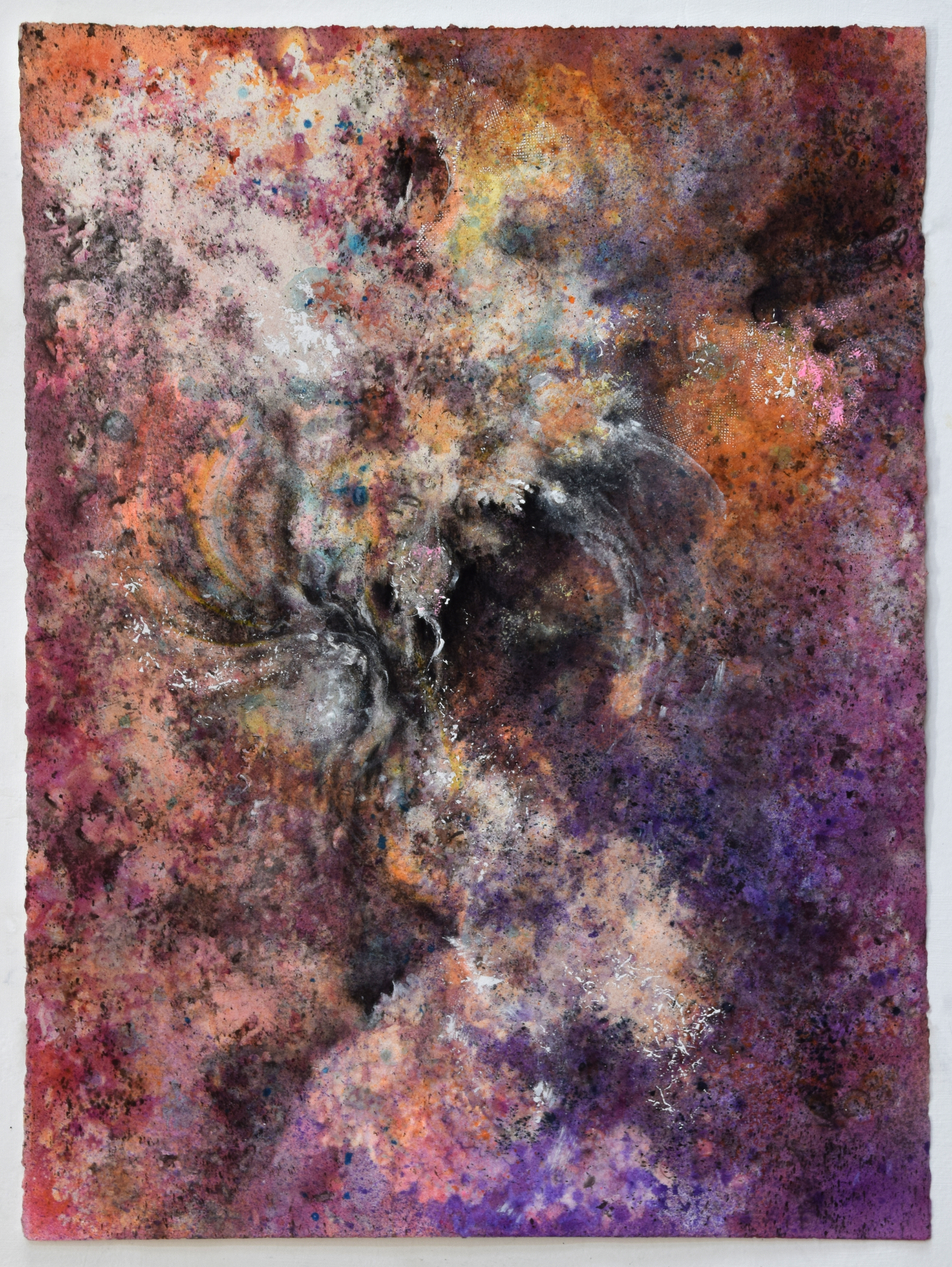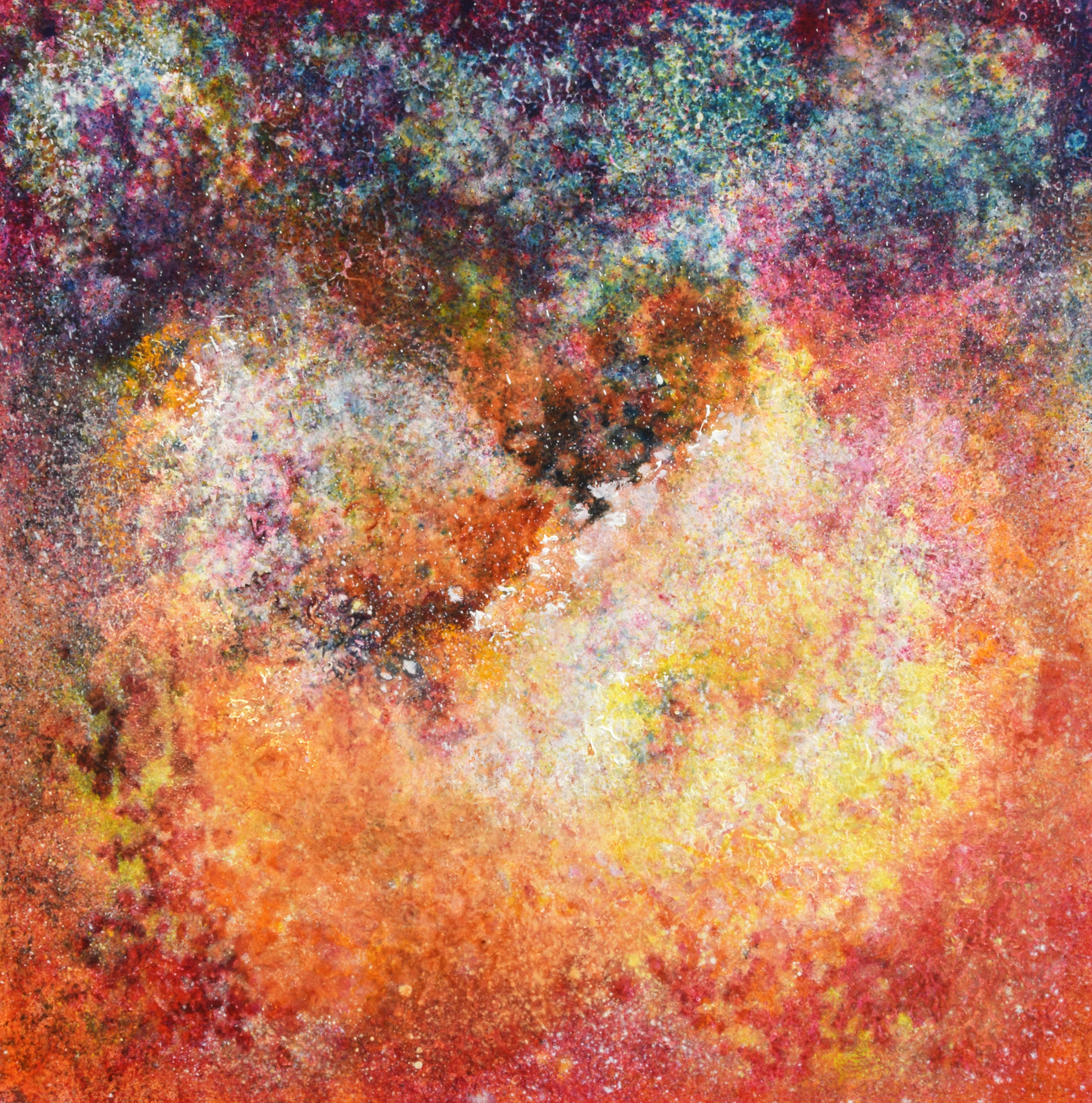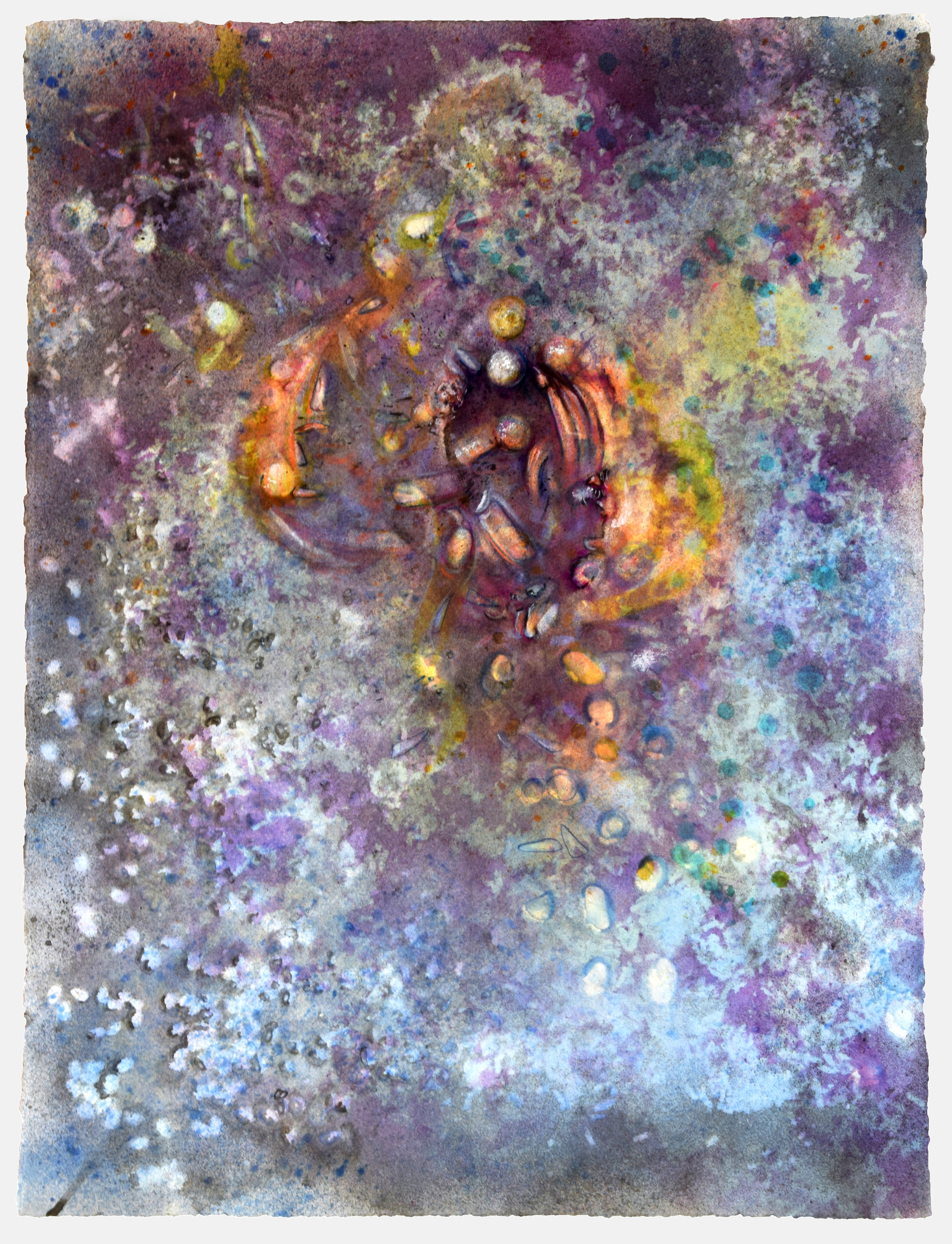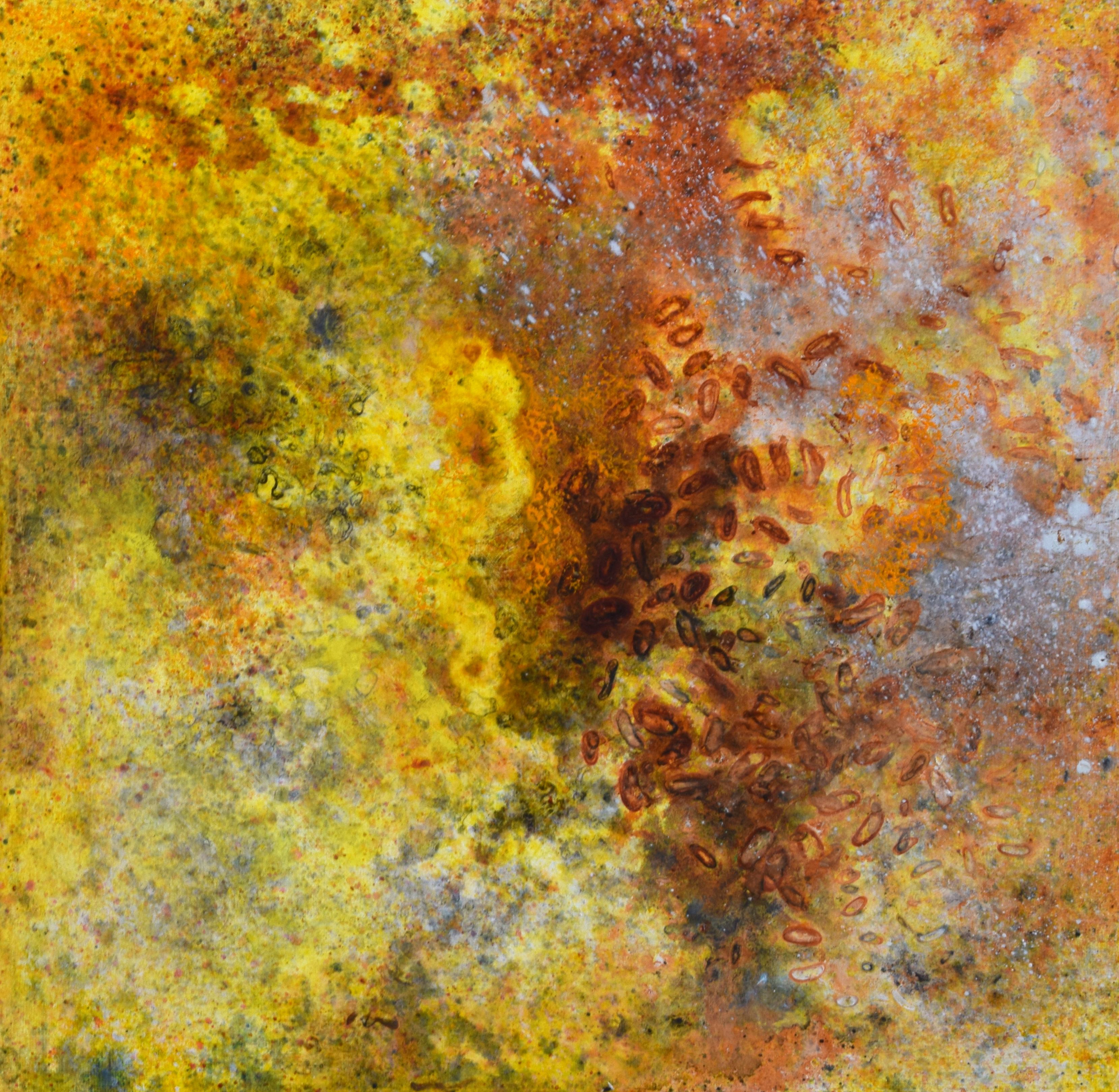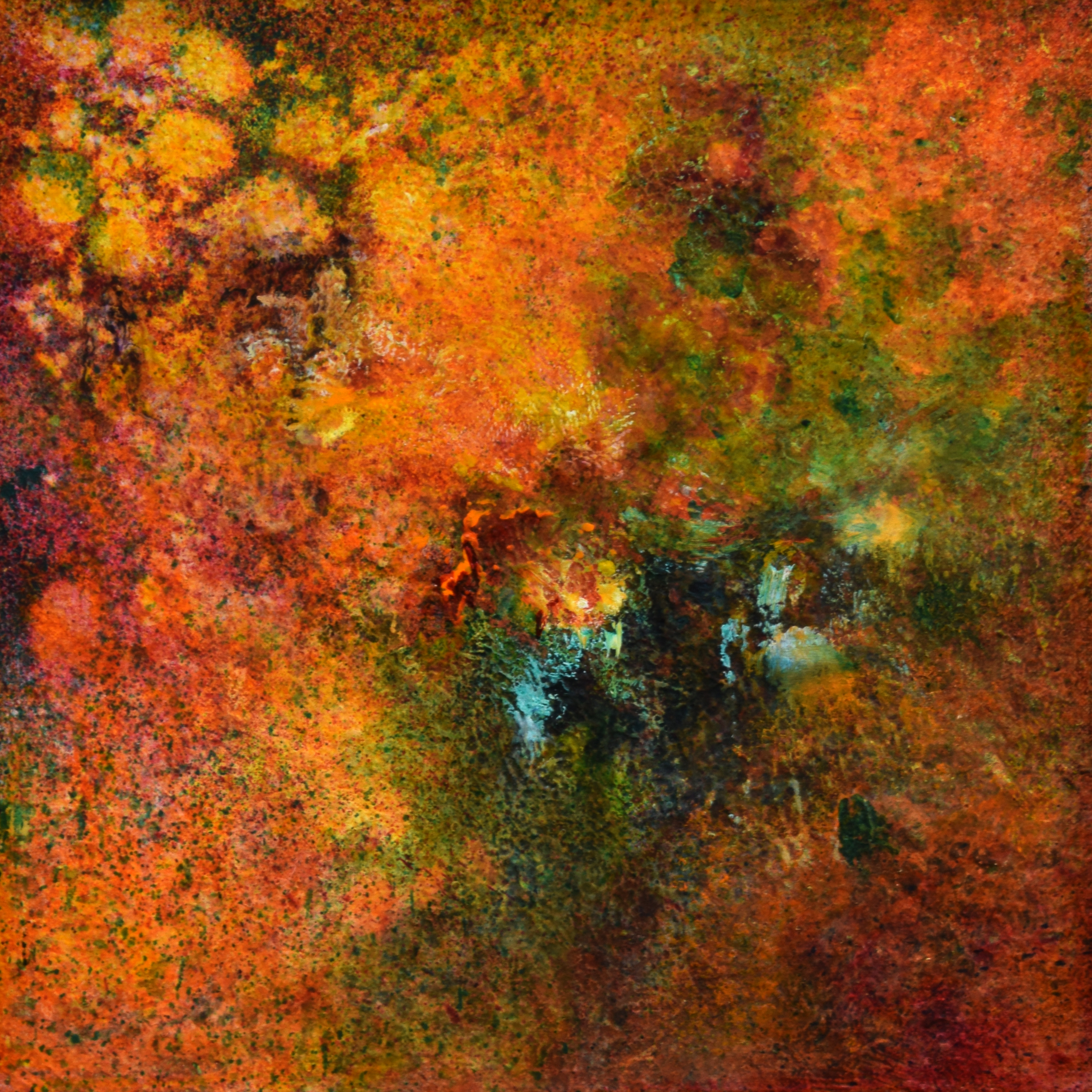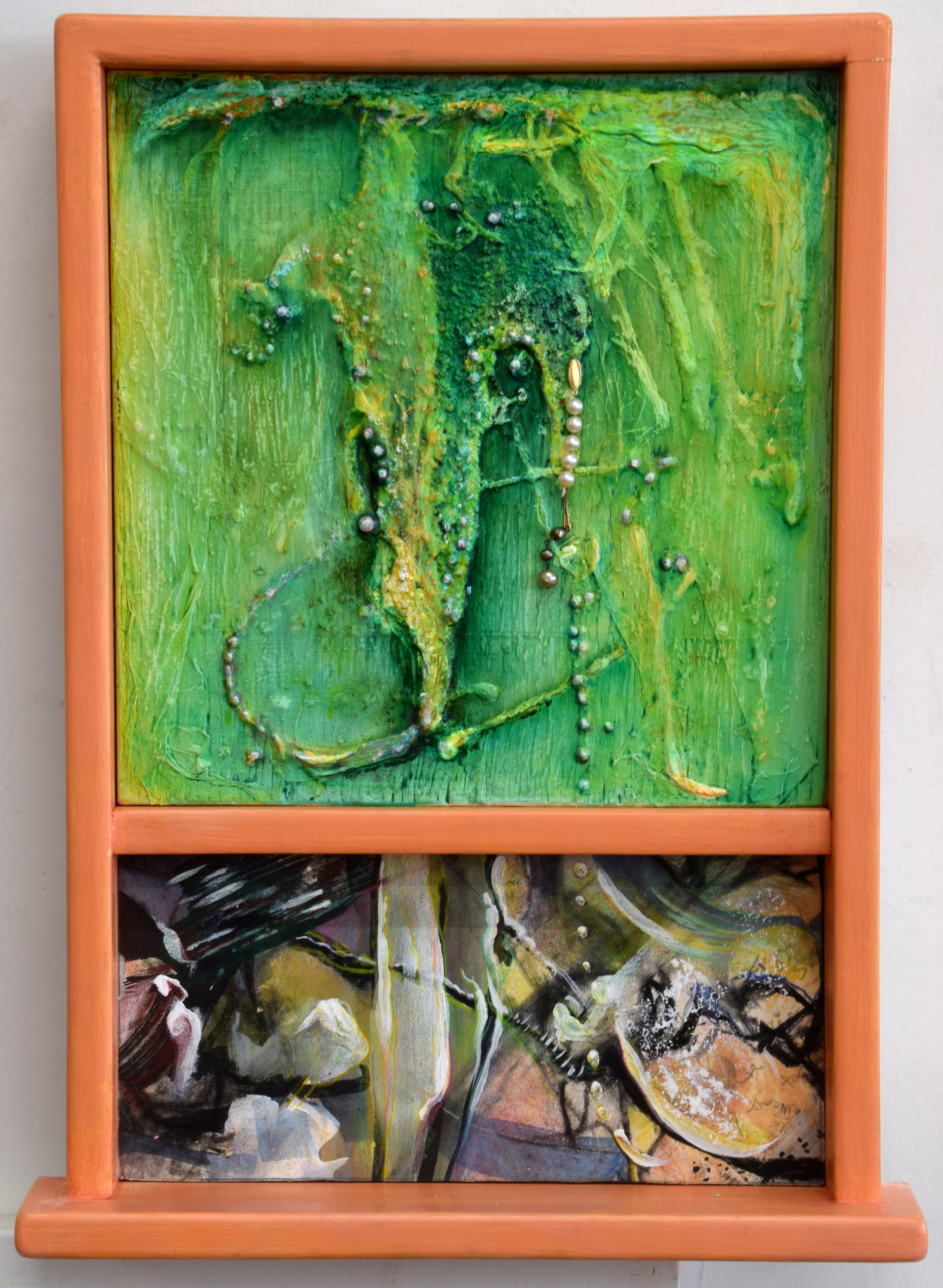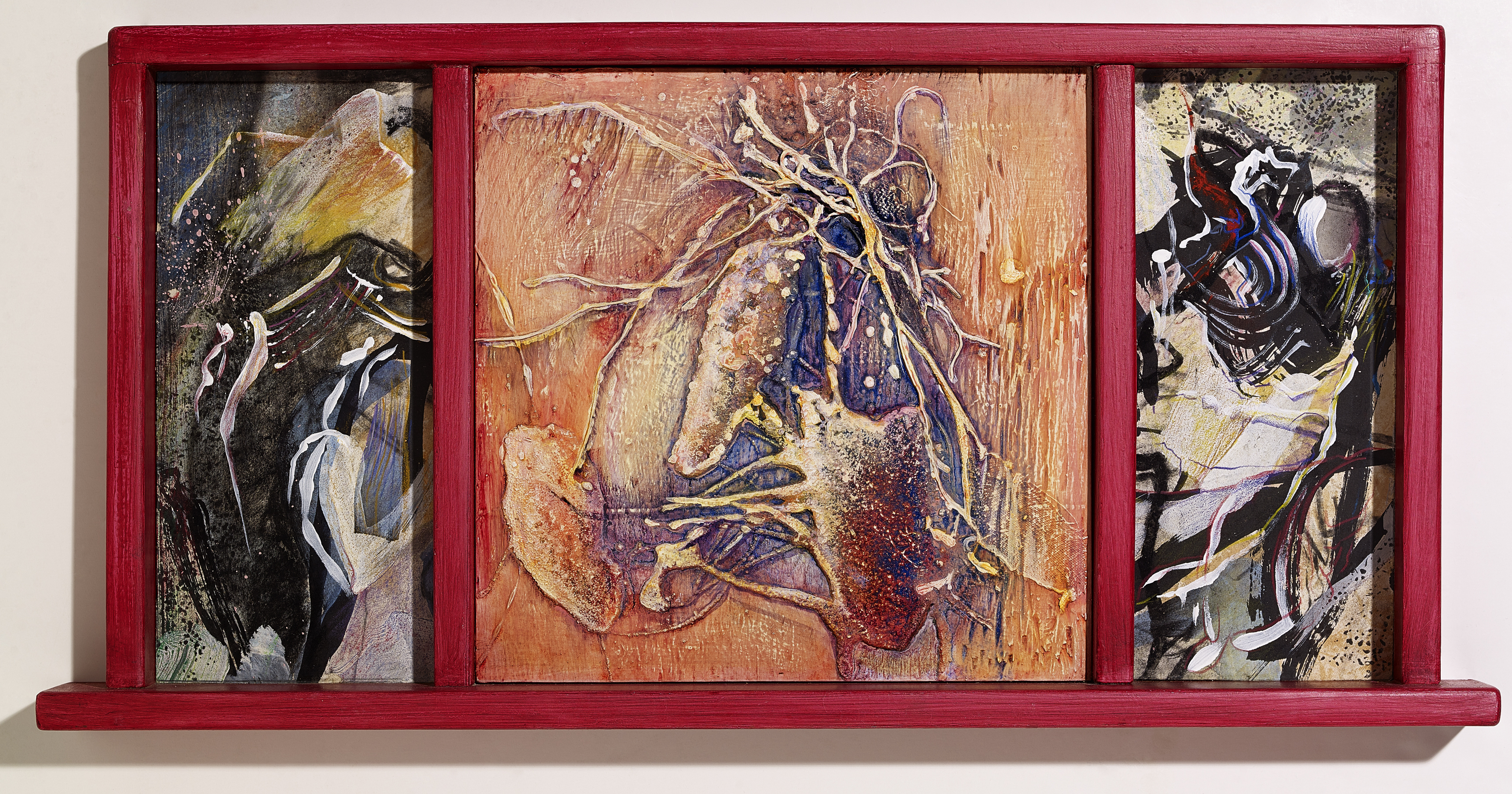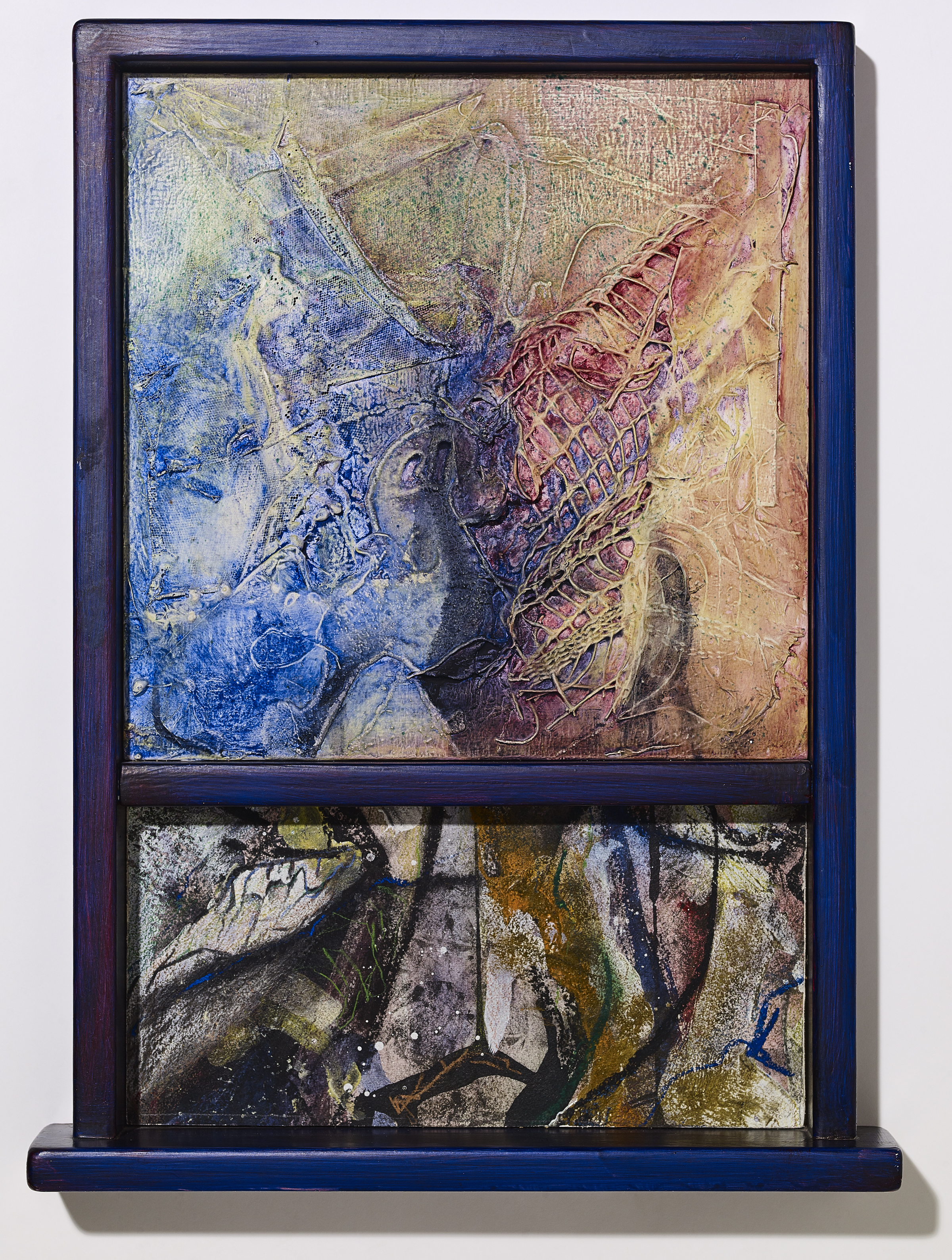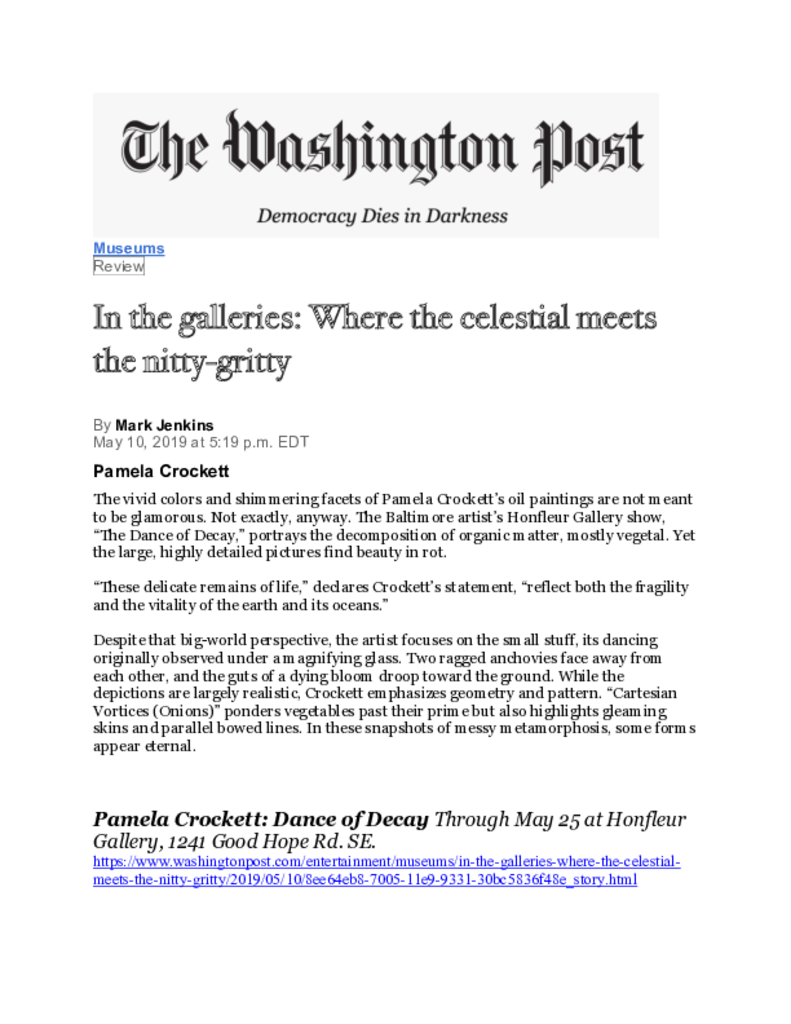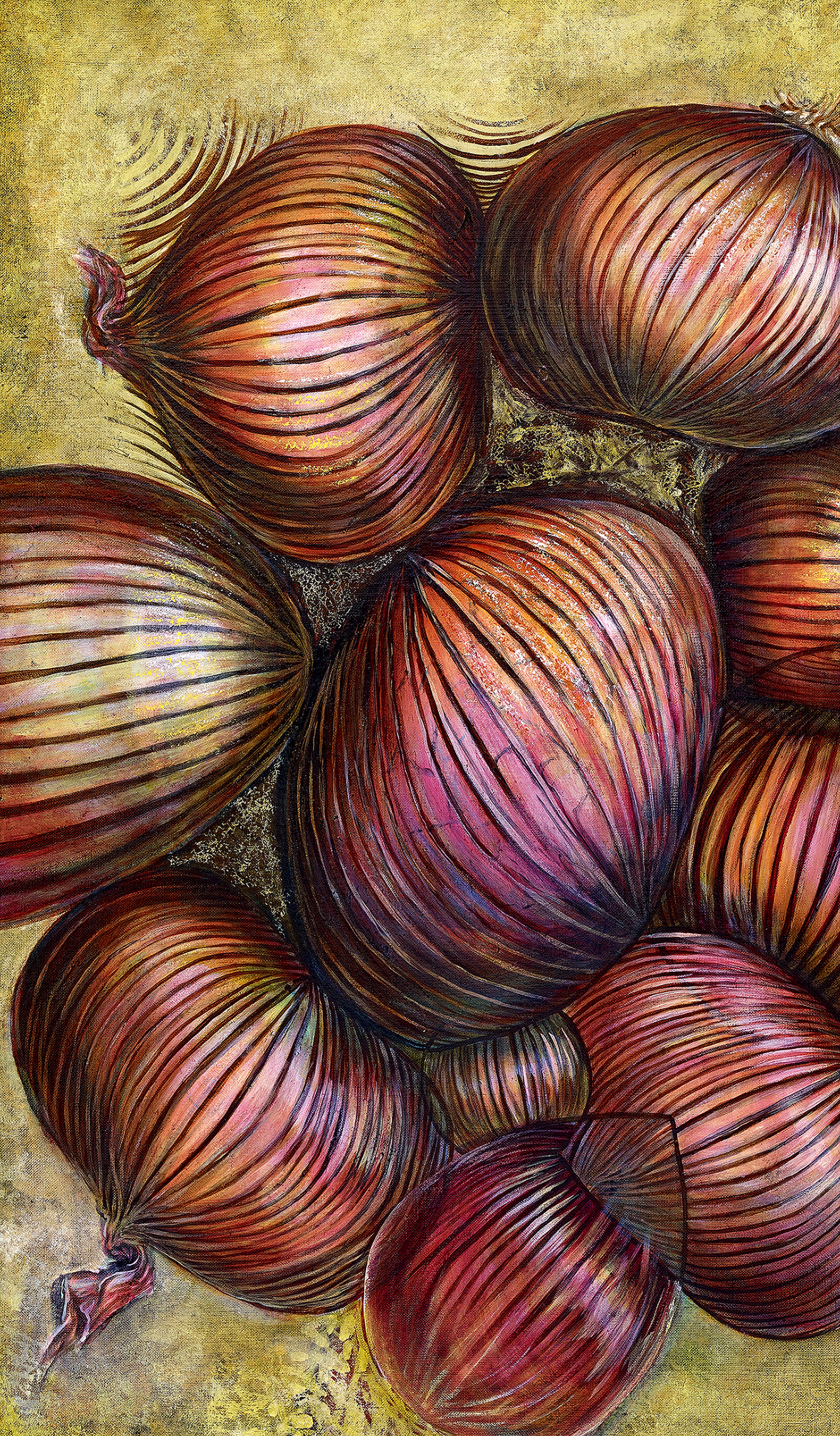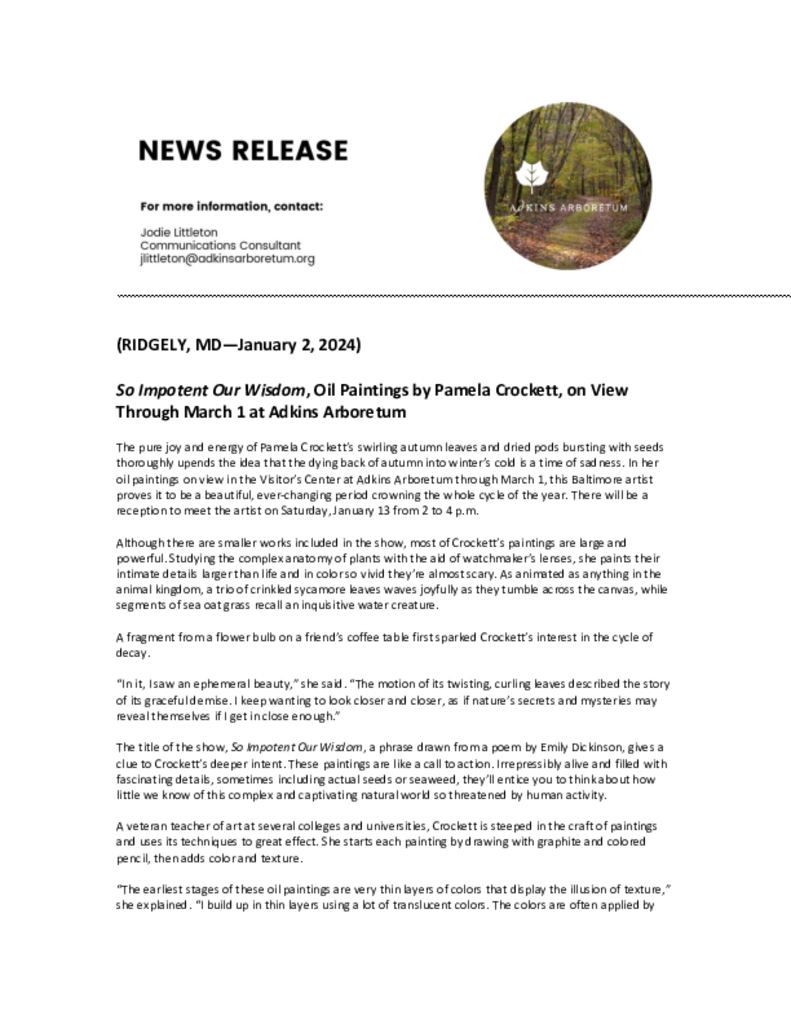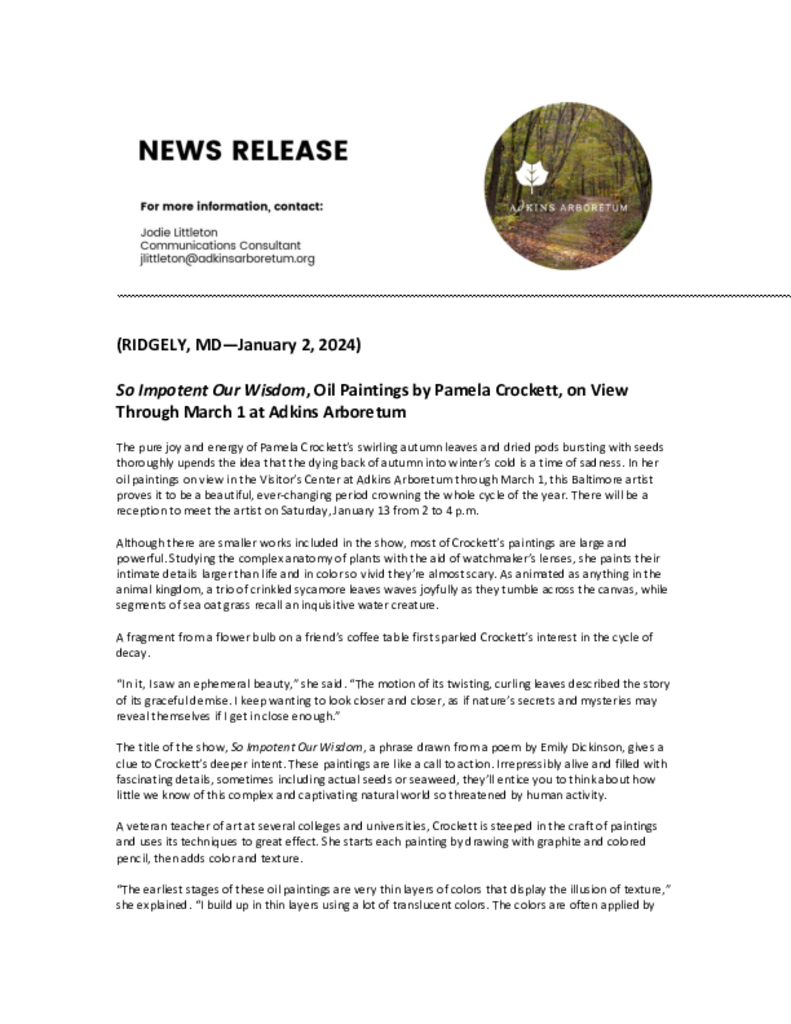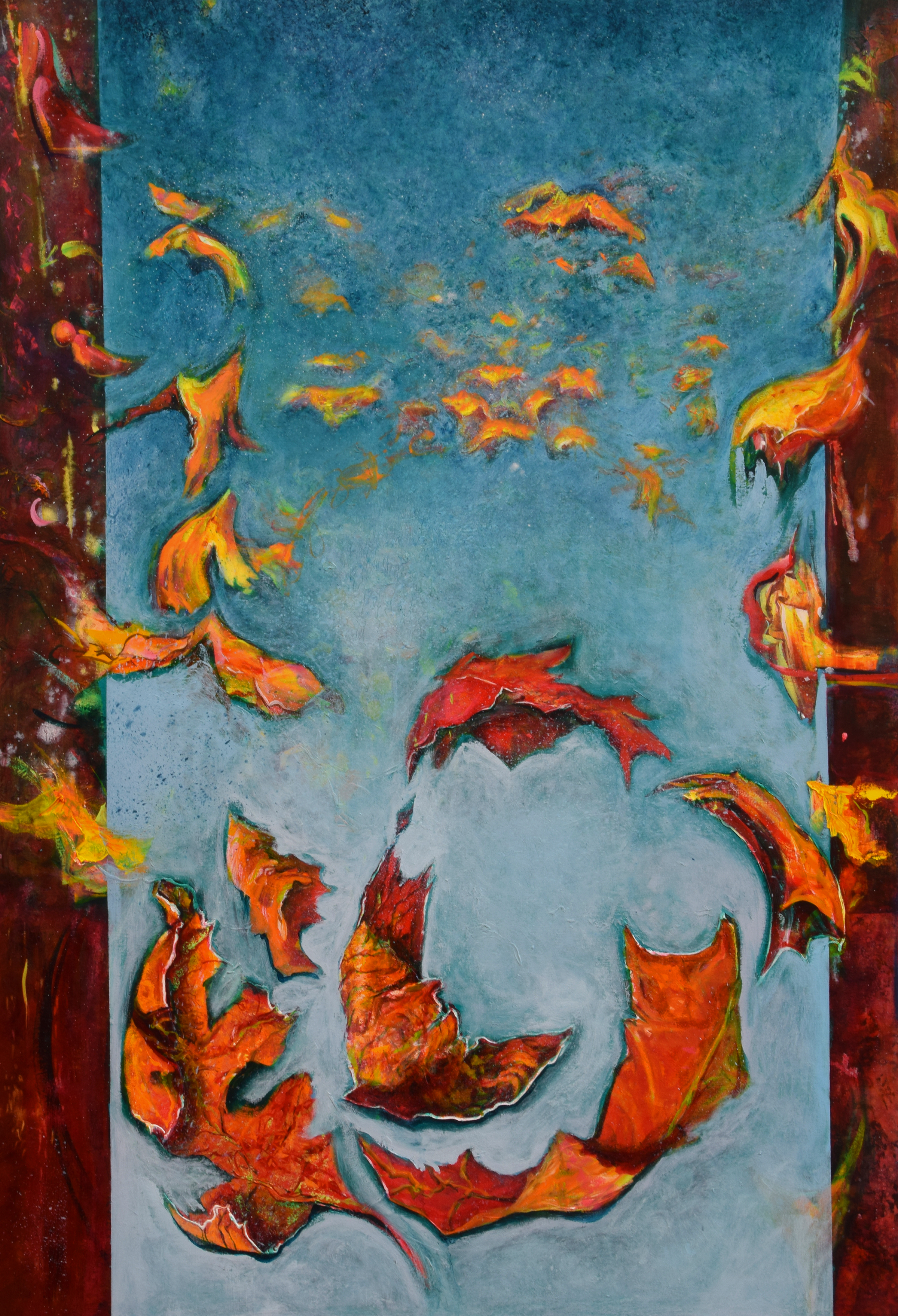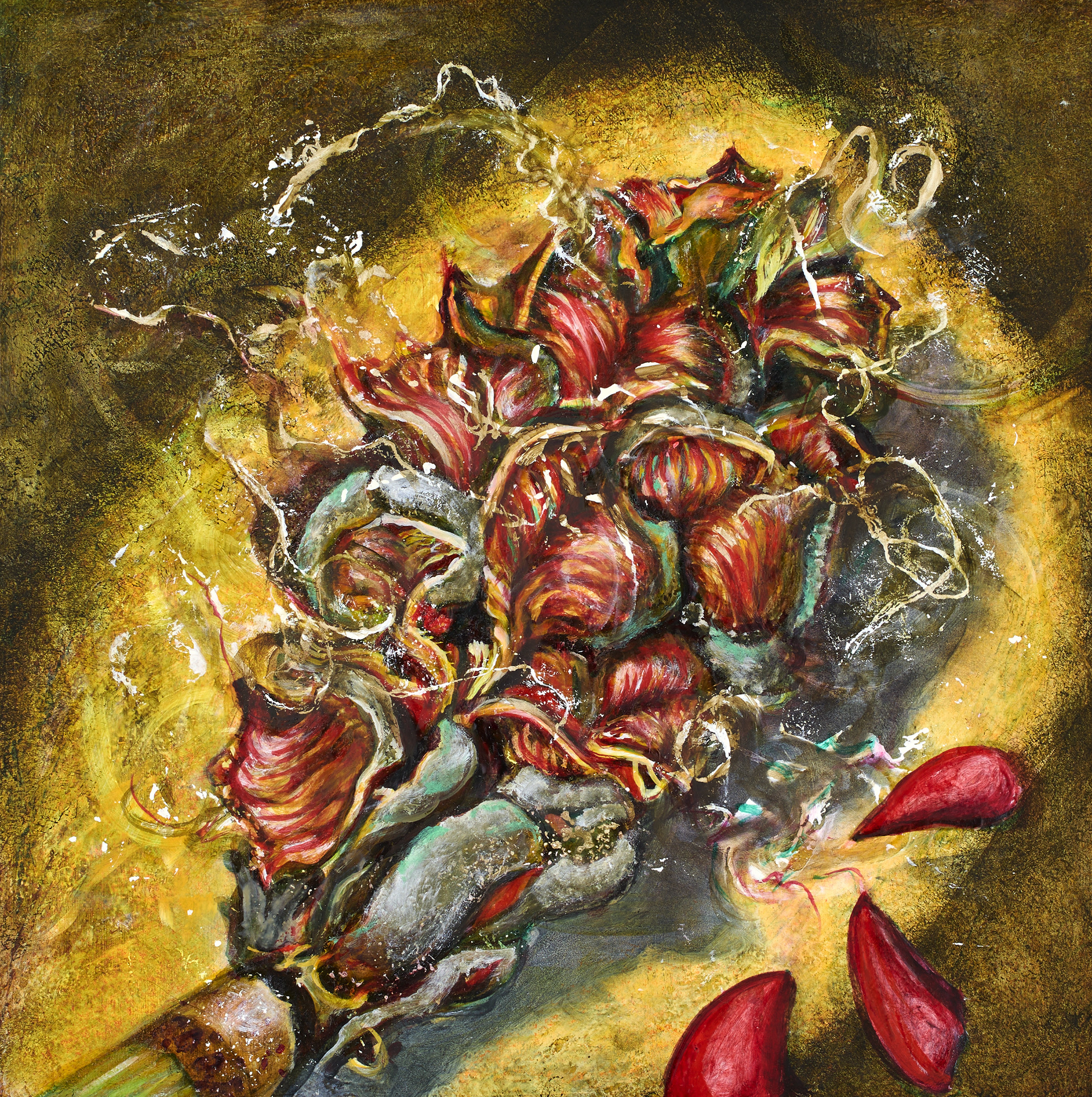About Pamela

In her paintings, Pamela Crockett imbues inanimate objects with life, and her attention to texture invites the viewer for a closer look. A former fellow in residence at the Virginia Center for the Creative Arts and recipient of the Olssen Faculty Incentive Award, Pamela has been painting and teaching since receiving her Master of Fine Arts and Masters of Arts degrees from the University of Iowa and undergraduate from Grinnell College. Teaching positions include Mt. St. Mary’s College,… more
BRAINWAVES
The shapes and movement in this project are loosely based on microscopic images of Amyloid Plaques and Tau Tangles found among the brain cells of Alzheimer’s patients. Sub-cortical images refer to dementias that occur below the cortex, such as Lewy bodies and Parkinson’s disease. Looking at tree bark and the sub-cortical patterns it created helped me find solace from personal struggles of losing my best friend and mentor to dementia this year.
-
 Sub-Cortical 1
Sub-Cortical 1Sub-Cortical 1 (below the bark), (36" x 27"), Mixed media: Gouache, saffron, paprika, coffee on BFK paper
(below the bark), refers not only to tree bark, but also what happens below the cortex of the human brain. Certain dimentias, such as Parkinson's and Lewy Bodies, occur in the sub-cortical part of the brain.
Available for Purchase -
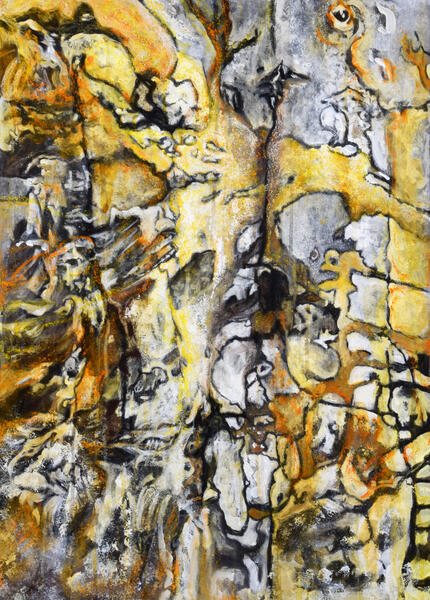 Sub-Cortical 2
Sub-Cortical 2Sub-Cortical 2, (Below the Bark), (35" x 26"), Mixed media: Gouache, saffron, coffee, paprika on paper
Available for Purchase -
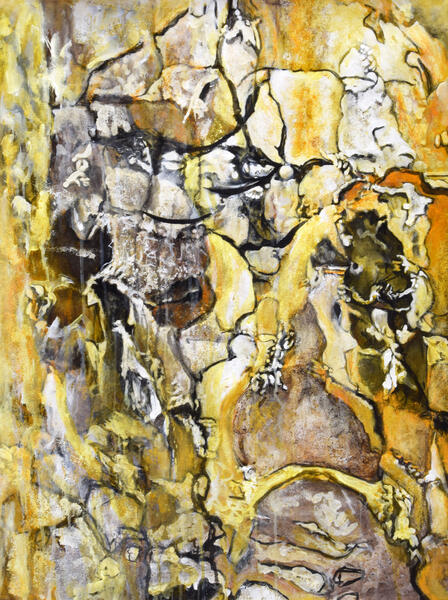 Sub-Cortical 3
Sub-Cortical 3Sub-Cortical 3, (Below the Bark), Mixed media: Gouache, saffron, coffee, paprika on BFK paper
Available for Purchase -
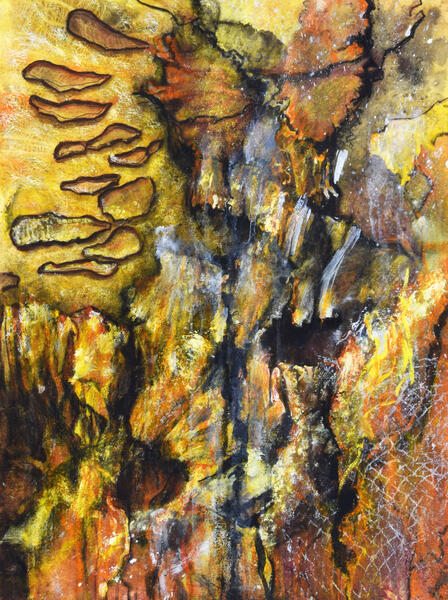 Sub-Cortical 4
Sub-Cortical 4Sub-Cortical 4, (Below the Bark), Mixed Media: Gouache, saffron coffee, paprika, pastel on Rives BFK paper, (36" x 27")
-
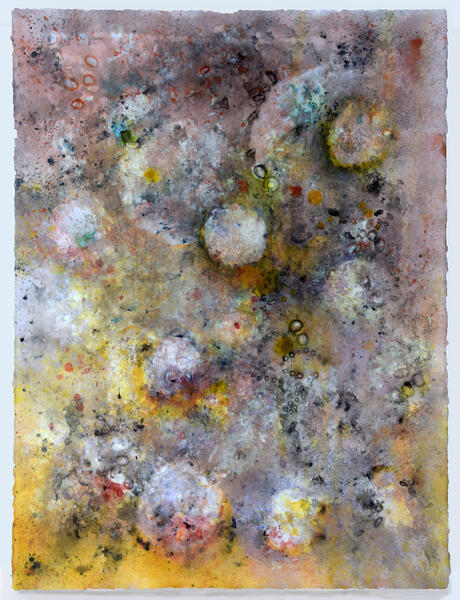 Brain Fog
Brain FogBrain Fog, Mixed media on BFK paper: Gouache, saffron, coffee, pastel, paprika (36" x 27")
-
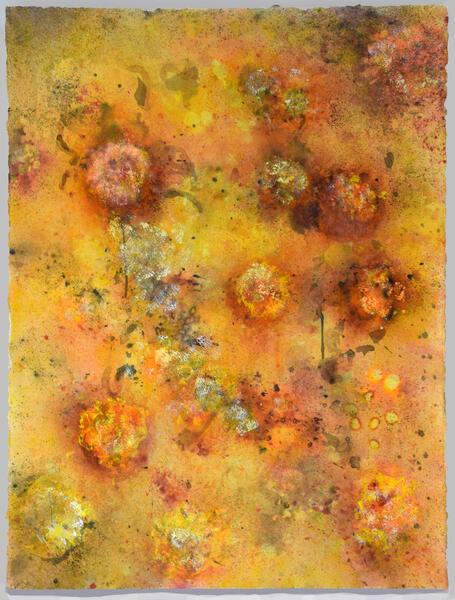 Amyloid
AmyloidAmyloid, Mixed media on BFK paper, (36" x 27")
-
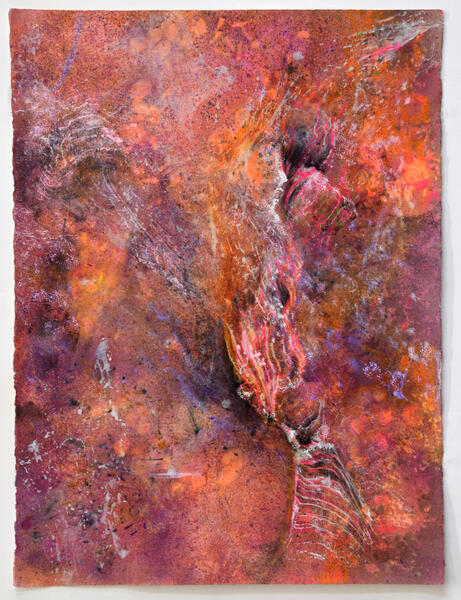 Tau Tangles
Tau TanglesTau Tangles, Mixed media on BFK paper, (36" x 27")
-
 Swirlpool
SwirlpoolSwirlpool, Mixed media on BFK paper, (36" x 27")
JOY OF FLYING/FEAR OF FALLING
Joy of Flying/ Fear of Falling
Unlike my highly textural oil paintings, these two-dimensional works on paper display the illusion of texture through experimental media. The process of displacing and dissolving chemical additives offers curious results. Here my inner turmoil takes visual shapes. The movement is an expression of my uncertainty of the future in my personal life, the environment, and our political climate.
-
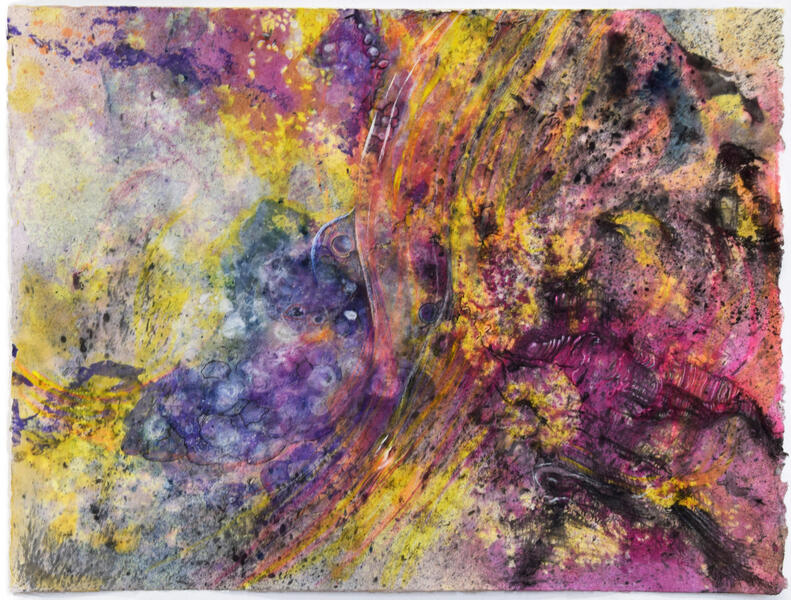 Rushing from Tangles
Rushing from TanglesRushing from Tangles, Mixed Media on BFK paper, (18" x 27")
-
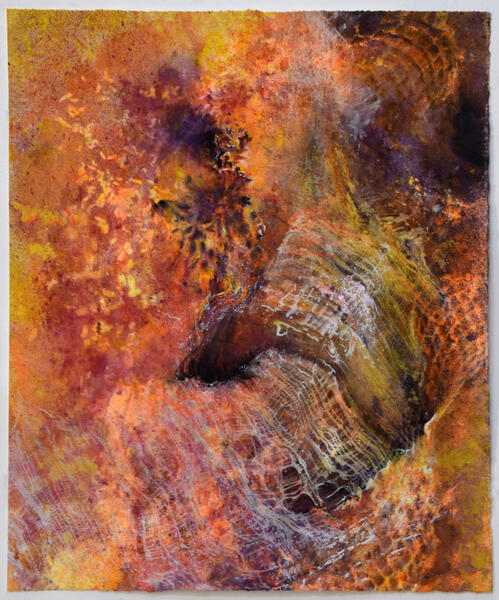 Bowl Tangles
Bowl TanglesBowl Tangles, (35" x 25"), Mixed media: gouache, pastel, colored pencil on BFK paper
-
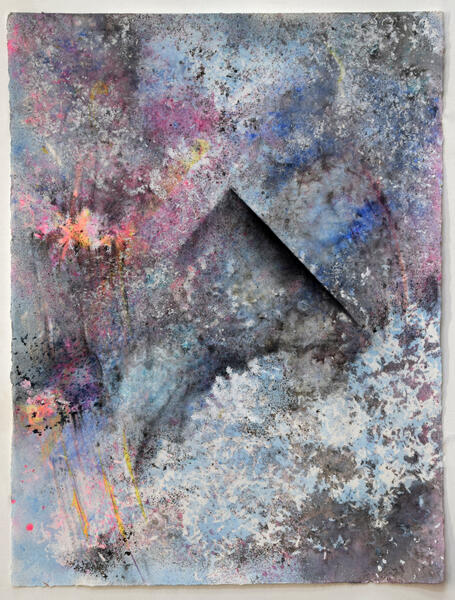 Joy of Flying/Fear of Falling
Joy of Flying/Fear of FallingJoy of Flying/Fear of Falling, Mixed Media on BFK paper, (36" x 27")
-
 Polar/ Non-polar Solvent
Polar/ Non-polar SolventPolar/ Non-polar Solvent, Oil on canvas
-
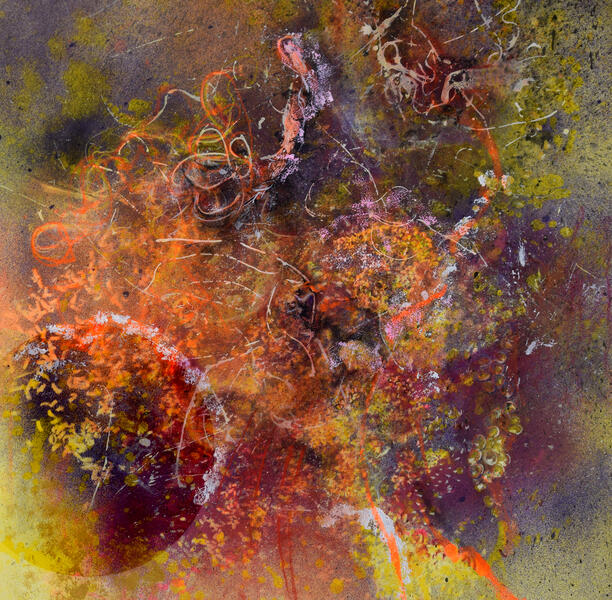 Am I Disappearing?
Am I Disappearing?Am I Disappearing?, Mixed Media on BFK paper, (23" x 24")
-
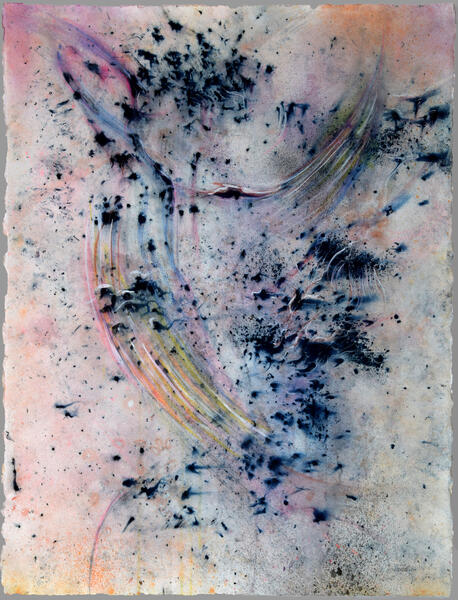 Murmuration
MurmurationMurmuration, (36" x 27"), Mixed Media: gouache, pastel, colored pencil on BFK paper
-
 All Fruits are Ovaries
All Fruits are OvariesAll Fruits are Ovaries, (36" x 27"), Mixed media: gouache, paster, colored pencil on BFK paper
-
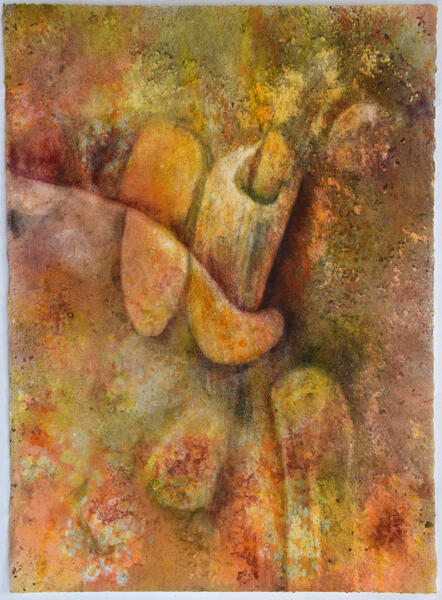 Fold Slide
Fold SlideFold Slide, Mixed Media on BFK paper, (36" x 27")
VISCERAL LOGIC
Fascinated by the chemical effects created by combining polar and non-polar solvents with my painting media, I find the process intriguing. Some of the components I use are rock salt, sand, silica desiccant, iron oxide, calcium chloride from ice melt, sodium bicarbonate, iron oxide, water droplets, beans, seeds, rice, shredded paper, string, and stones.
The effects are at once surprising and exciting, reflecting the urgency of seasonal change and the fleeting nature of life on earth. As Mary McCoy says about these images, “Far more than simply depicting autumn leaves, drops of paint bloom like galaxies. The images are meant to evoke both the cycle of the seasons and the interrelationship of all the elements of the cosmos.”
-
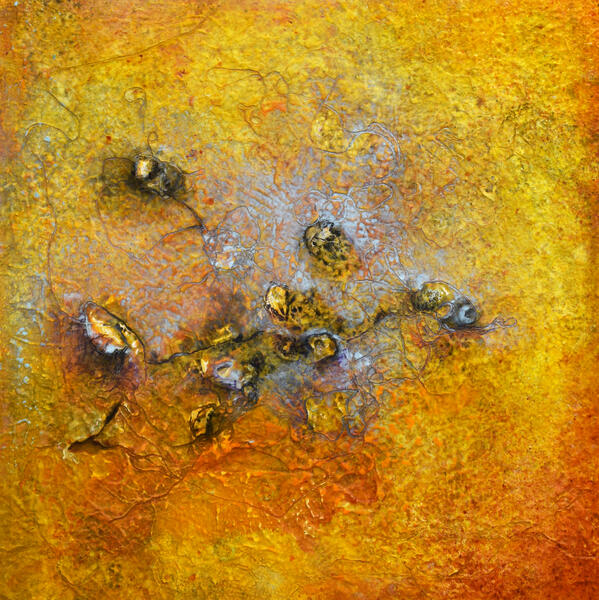 Bare Bones
Bare BonesBare Bones, (14" x 14"), Oil on panel
Highly textural, the bare bones are revealed as surface detritus is removed.
-
 Divisions
DivisionsDivisions, Oil on linen on panel, *14" x 14"
-
 Visceral Logic
Visceral LogicVisceral Logic, Oil on panel, (14" x 14")
-
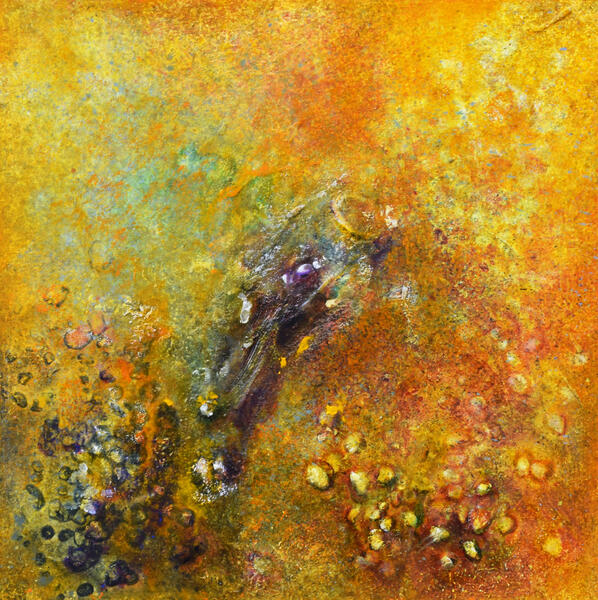 Shooting Star
Shooting StarShooting Star, (14" x 14"), Oil on Linen on Panel
-
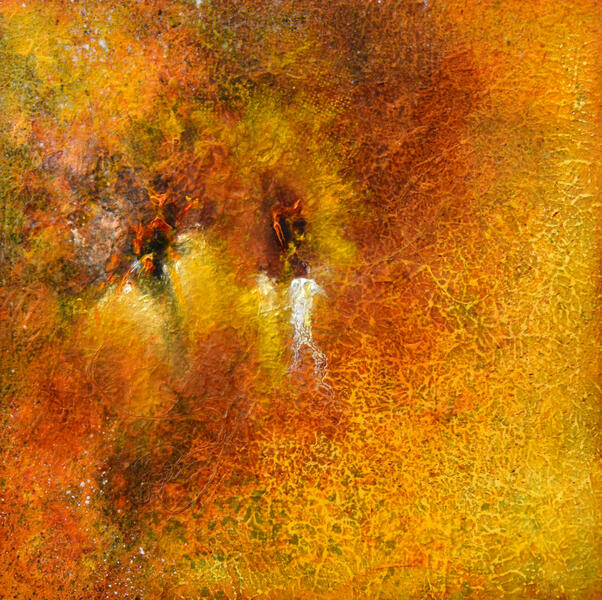 Rust Streak
Rust StreakRust Streak, Oil on panel, (14" x 14")
-
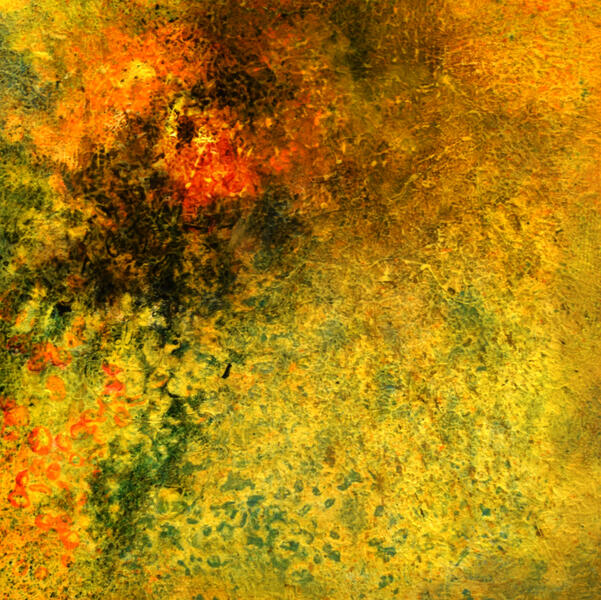 Galactic Spring
Galactic SpringGalactic Spring, (14" x 14"), Oil on panel
-
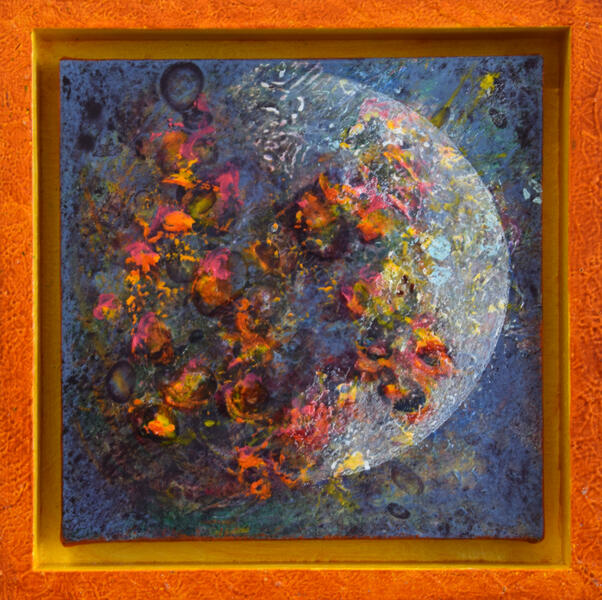 Lunar Push
Lunar PushLunar Push, Oil on linen on panel in box, (12" x 12")
-
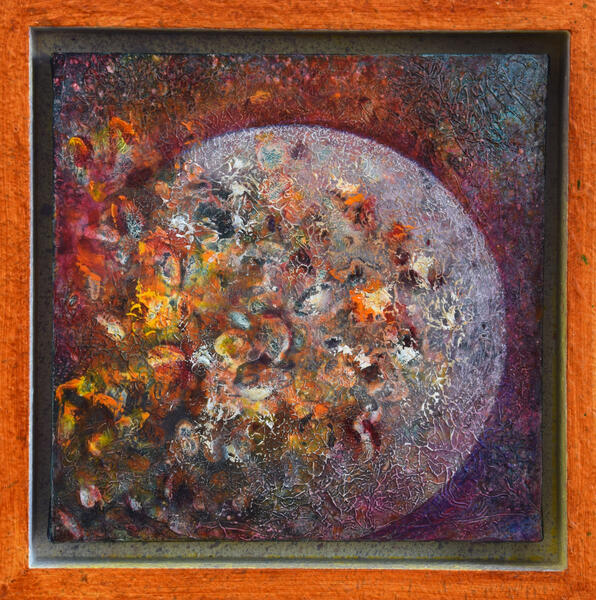 Lunar Push 2
Lunar Push 2Lunar Push 2, Oil on linen on panel in box, (12" x 12")
-
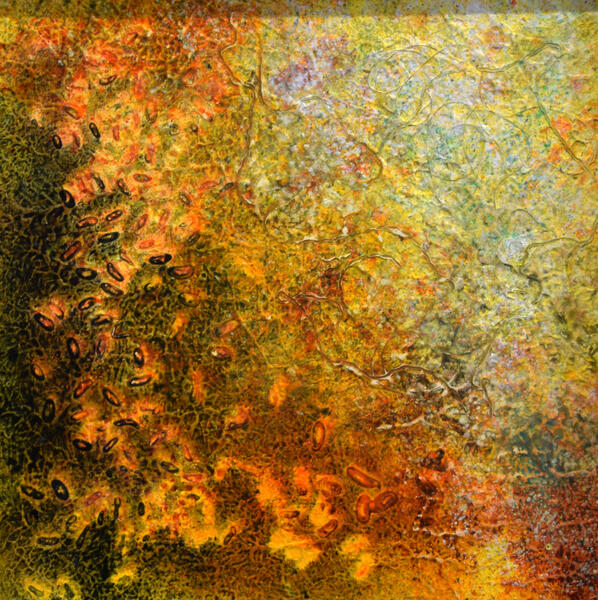 Meridian
MeridianMeridian, Oil on linen on panel, (14" x 14")
-
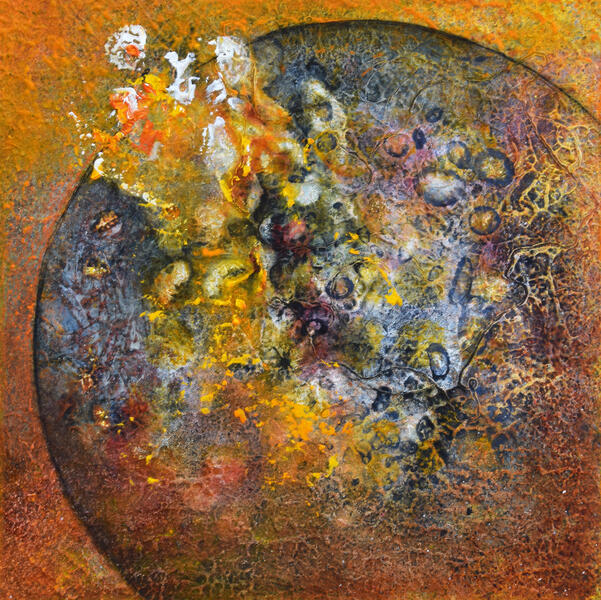 Moon Disturbances
Moon DisturbancesMoon Disturbances, Oil on panel, (14" x 14")
WINDOWS FOR OLIVER SACKS
Like selected works in my “Tactile Memories” series, some of these paintings have been included in "tactile" exhibitions, where the participants are encouraged to use sequential touch in exploring the artworks. Recently included in the exhibit "Awaken" at Towson University (summer 2024), the curator's description is as follows:
“Famed neurologist Oliver Sacks studied the oddities of the brain, from color and dreams to phantom limbs. Dedicated to Sacks, and inspired by one of his patients who was born blind, Crockett’s Windows series explores the relationship between sight and touch. The top portion of the panels mix various objects such as Braille paper, sand, string, gauze, cotton, and fabrics covered in gesso and oil paint; the bottom is created blindly by pushing around other sensory-stimulating objects including nuts, seeds, sponges, etc. soaked in paint onto rolls of BFK paper. This juxtaposition of textures challenges perceptive norms and encourages the use of sequential touch. The multi-sensory windows combine art and science, a fitting tribute to Sacks, whose own work was readily adapted to film and opera.”
-
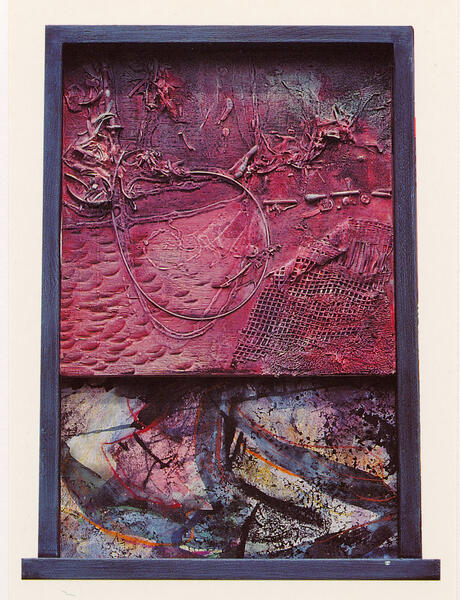 Beyond the Pane Window
Beyond the Pane WindowBeyond the Pane, Paritally open Window
(22" x 16") Oil paint on panel with mixed media textures (top), Blind drawings on BFK (bottom)
-
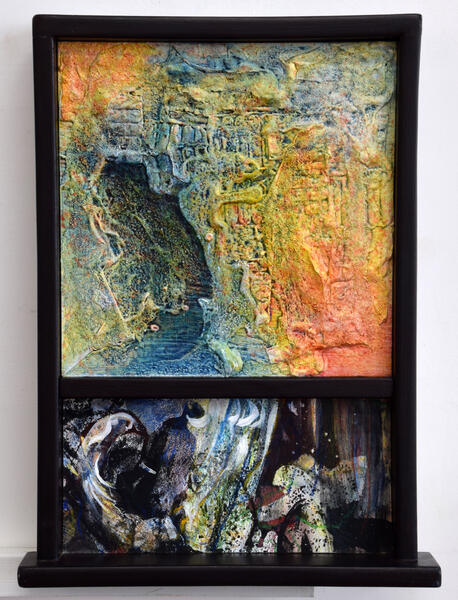 Wave Window for Sacks
Wave Window for SacksWave Window for Sacks (22" x 16"), Oil paint on textures (top panel) Ink, pastel, and colored pencil on BFK paper (bottom panel)
-
 Apricot Pearl Braille
Apricot Pearl BrailleApricot Pearl Braille, (22" x 16) Oil paint on panel with mixed media textures (top), Blind drawing on BFK (bottom)
-
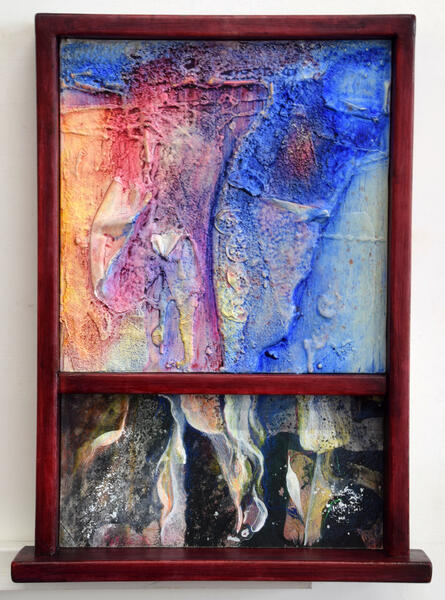 Window: Red/Blue Curtains for Sacks
Window: Red/Blue Curtains for SacksWindow: Red/Blue Curtains for Sacks, (22" x 16"), Oil paint on textures (top panel) Ink, pastel, and colored pencil on BFK paper (bottom panel)
-
 Heart Fly Window
Heart Fly WindowHeart Fly Window, (16" x 24") Oil paint on panel with mixed media textures (center), Blind drawings on BFK (sides)
-
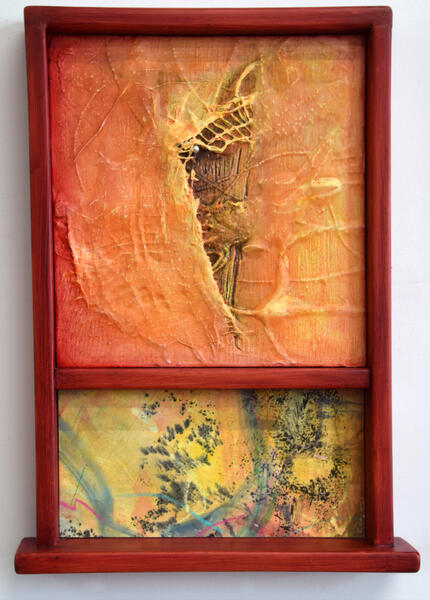 Hidden Pearl on Braille paper with net
Hidden Pearl on Braille paper with netHidden Pearl on braille with net, (22" x 16) Oil paint on panel with mixed media textures (top), Blind drawing on BFK (bottom)
-
 Window One for Sacks
Window One for SacksWindow One for Sacks, (22" x 16"), Oil paint on textures (top) Ink, pastel, and colored pencil on BFK paper (botton)
-
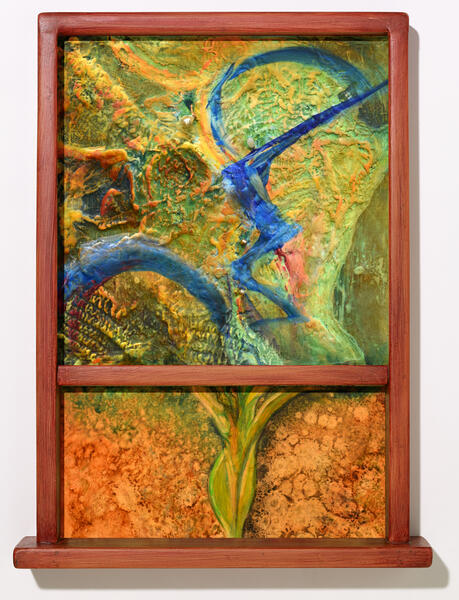 Bulb Shoot Window
Bulb Shoot WindowBulb Shoot Window, (22" x 16) Oil paint on panel with mixed media textures (top), Blind drawings on BFK (bottom)
DANCE OF DECAY
DANCE of DECAY
A delicate balance between our environment and our human interaction with it drives these images. This relationship reveals itself to me as I study shapes of decomposition and microbial patterns through watchmaker's lenses. By animating decomposing pods, seeds and aquatic fragments, I find that these rotting remains of life reflect both the fragility and the vitality of the earth and its oceans. Washington Post journalist Mark Jenkins observes that “In these snapshots of messy metamorphosis, some forms appear eternal.”
Contained in these images are my fears and my hopes in response to our current climate crisis. The earth I have always depended on is undergoing dramatic change. And yet, the patterns of decay are constantly surprising me. Although I use close observation, these paintings are not strictly representational. My tendency is to amplify minute details, to pump up color saturation, and to intensify contrast to the point where the image becomes something altogether different. Observation of dead, inanimate objects offers me the challenge to imbue them with movement and activity. As described by Lesley Wright, director of the Grinnell College Museum of Art, from the exhibit "Nature Made, “The scale is so large and the colors so vivid that they are humorously monstrous.”
-
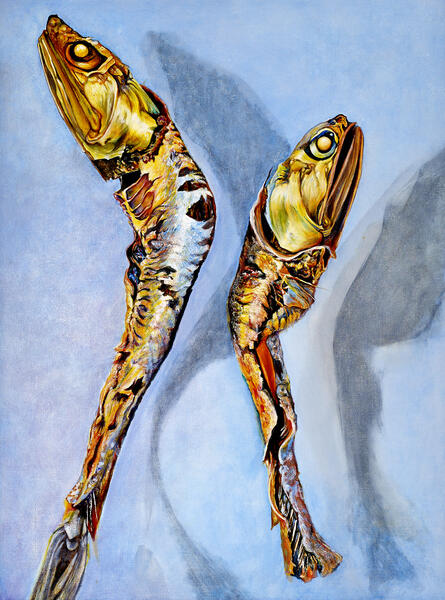 Anchovy Dance
Anchovy DanceAnchovy Dance, Oil paint on linen, (50” x 38”)
Dried fish served as the model for this painting. As the anchovies headed toward rot, their colors became more iridescent. I tried to replicate this shimmering through layers of translucent oil paints. The crunchy texture of the anchovies is evident, but unfortunately as I handled the fragile fish, they kept breaking apart and falling to the floor.
-
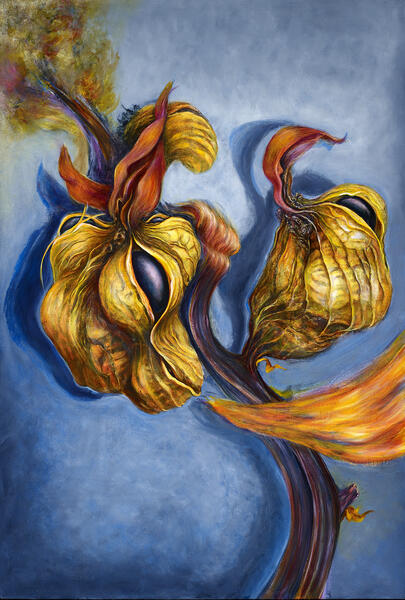 Canna Seed Baskets
Canna Seed BasketsCanna Seed Baskets, Oil on canvas, (52” x 36”)
The composition of this painting comes from a dried clump of decaying seeds and leaves of the Canna Lily. After the flowers die off, the regenerative baskets appear. Its woven container, like the one I carry to the farmer's market, is full of black seeds resembling miniature bowling balls about to fall out of frayed burlap sacks.
-
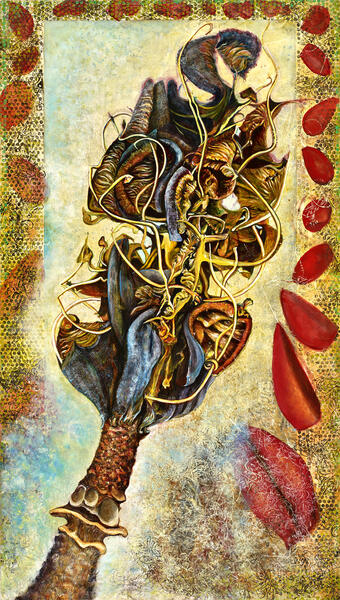 Visible Strings
Visible StringsVisible Strings, (Magnolia grandiflora), Oil on linen, (62” x 36”)
Attracted by an unrecognizable bit of decaying matter, I observed the structure and lines of this dried magnolia pod. Working in reverse chronology, this painting shows various points in the passage of time. And, of course the word play on Invisible String Theory is no coincidence.
-
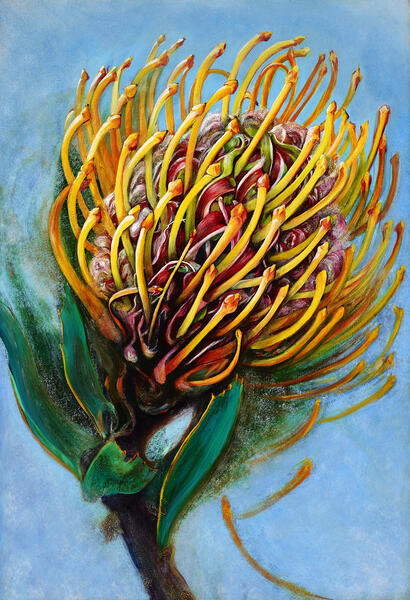 Shapeshifter Protea
Shapeshifter ProteaShapeshifter Protea Oil on canvas, (52” x 36”)
During observation, this specimen went through many transformations: finding its structure proved to be both baffling and intriguing. Ribbons unfurled, pins sprouted, and seeds appeared. Only after completion of the painting did the specimen’s name make sense to me: the mythological Proteus was a shapeshifter.
-
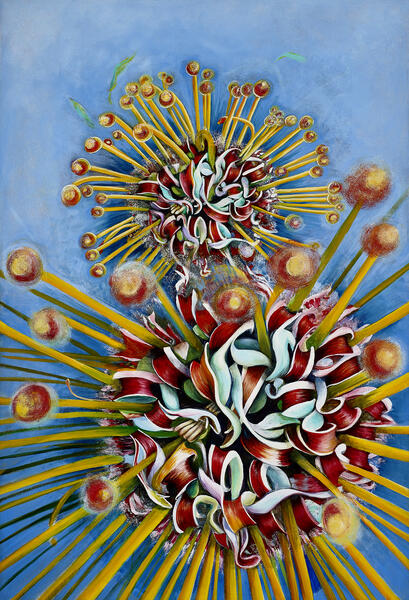 Double Protea
Double ProteaDouble Protea, Oil on canvas, (52” x 36”)
As we were in the early stages of a pandemic, I began this painting based on the images of Covid-19 there were in the news. But then the painting transformed into a study of the shape-shifting pincushion protea. The image displays simultaneous views, one up close and one farther away.
-
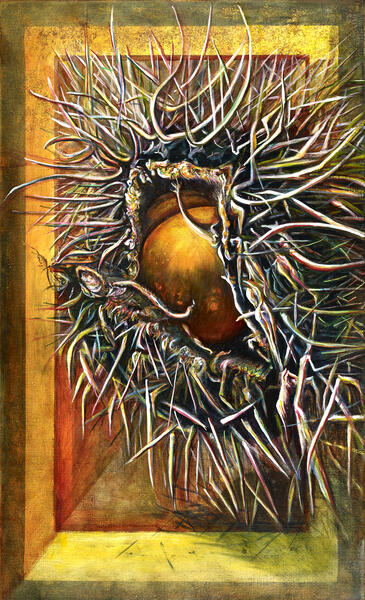 Split Chestnut Burr
Split Chestnut BurrSplit Chestnut Burr, (32” x 20”) Oil paint on linen
Here the sharp needles protecting the inner sanctum of the chestnut seeds act as protection. The image has been described as "almost scary," humorously monstrous," and "like an alien." In searching for the natural patterns of decay, I am noticing dead plants are not stagnant, but fully animated. Nature is powerful. And painful if you step on it in the wrong way.
-
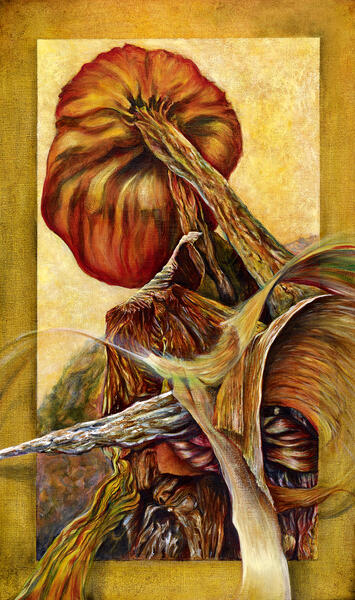 Twisting Bulb
Twisting BulbTwisting Bulb, Oil on linen, (32" x 20)
My curiosity about the cycle of decay began several years ago as I observed a dried bulb on my friend’s coffee table. In it, I saw an ephemeral beauty. The motion of its twisting, curling leaves told the story of its graceful demise. I kept wanting to look closer and closer, as if nature’s secrets and mysteries might reveal themselves, if only I could get in close enough. To that end I used watchmaker’s lenses to study the complex anatomy of seeds and plants.
-
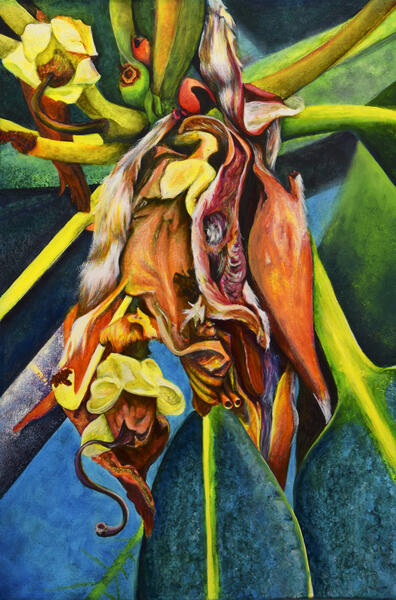 Regeneration
RegenerationRegeneration, (Rhododendron), Oil on canvas, (31” x 21”), Oil paint on canvas
In a vibrant ecosystem, the process of decay is a cyclical dance in which the various agents play their parts. Sun, rain, wind, and insects all have assigned roles and are inscribed into the choreography. Even as the drooping blooms fall, the smallest seed peeks out, hinting at its potential for new growth.
-
 Cartesian Vortices
Cartesian VorticesCartesian Vortices, Oil on linen, (32" x 20")
By observing drying onions, I discovered a parallel to Rene Descartes’ theory of movement among celestial bodies. Based on the scientist’s 17th-c. diagram of ether, my painting evokes the invisible forces that animate things large and small: not only the heavenly planets, but also the earthly onion.
SEASONING: A PALPABLE URGENCY
SEASONING: A PALPABLE URGENCY
The cyclical nature of seasonal change usually evokes reassurance that the patterns will right themselves. The natural energy of decay, destruction, and regeneration contains hope. And yet, lately, seasonal change and natural forces seem to display a palpable urgency. Stirrings created by human division and miscommunication are inherent in many of the images in my studio. I tried to capture this divisive energy in the intimate details and to reproduce them larger than life.
Often the images spring from natural forces I observe: flowing water, animal tracks in the mud, patterns left by the passage of wind, scattering seeds, skittering leaves, bird murmurations, or stars across an open field of color. A curator says, “If you look closely, you can never be sure whether you’re seeing the vastness of the cosmos or the infinity of microscopic worlds.”
-
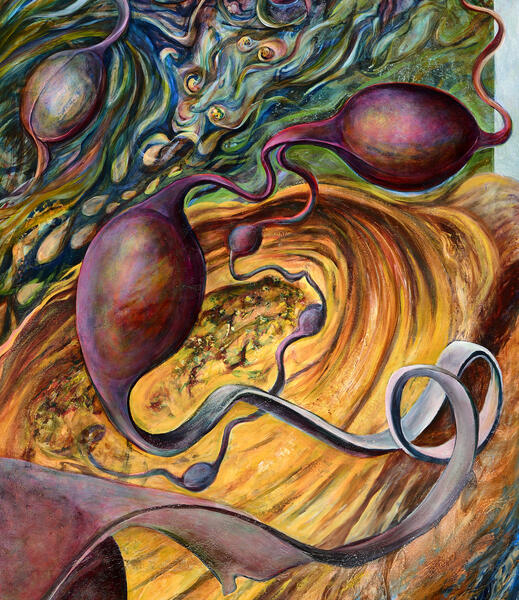 Flotation Devices in Crisis
Flotation Devices in CrisisFlotation Devices in Crisis, Oil on Canvas, (62" x 36")
The subject of this painting is at once small enough to fit in the palm of a hand and large enough to exist outside our planet. Its background contains huge cloud formations around Jupiter, and the purple bladder shape comes from the tiny Sargassum seaweed common in the Atlantic Ocean. Its air-filled bladder is helpful in keeping the plant afloat, providing food for ocean life and birds. Ironically, as catastrophic climate change brings flooding, tornadoes, heat waves, and fires, the lifesaving bladder shape offered me hope in its resilience and resourcefulness.
-
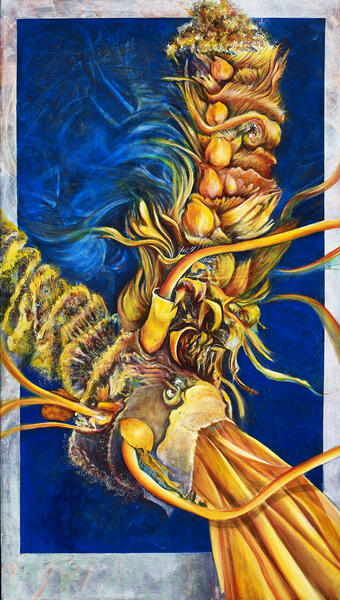 Unraveling Sea Oat
Unraveling Sea OatUnraveling Sea Oat, (Uniola paniculata), Oil on linen, (62” x 36”)
Inspiration comes from a small, decayed root found in the dunes of the Atlantic coast. Revealed to me in its seeds are the tools for animating a multitude of sea creatures, and the unraveling pattern of one tiny root recalled the delicate balance in our endangered surroundings.
-
 Seasoning
SeasoningSeasoning, Oil on canvas, (60" x 42")
One fall day, a gust of wind blew the leaves from the trees behind my studio. The urgency of the season whispered to me this metaphor as the leaves were making their final descent. There were so many that they appeared to be sprinkling from a giant salt shaker or scattering a handful from a chef’s fingers, seasoning the woods in splendor.
-
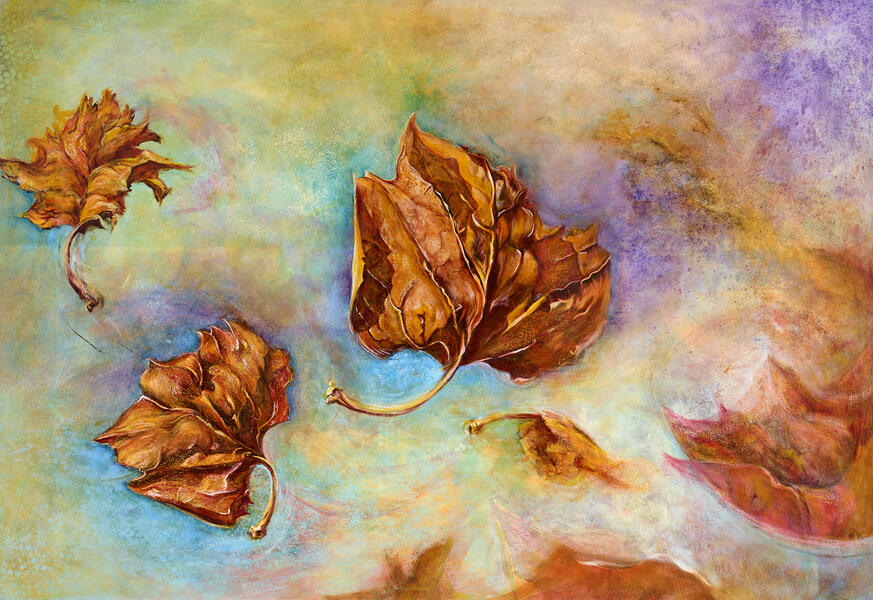 Fading Fall
Fading Fall"Fading Fall", Oil on canvas, (42" x 60") The natural energy of decay, destruction, and regeneration had a palpable urgency to it this year. As my best friend and mentor was losing her memory, it felt as if I were disappearing.
-
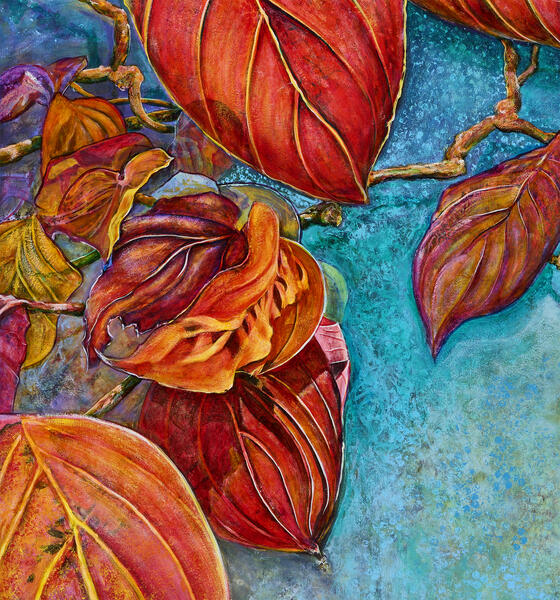 Curling Cascade (detail)
Curling Cascade (detail)"Curling Cascade" Oil on canvas, (52" x 36")
-
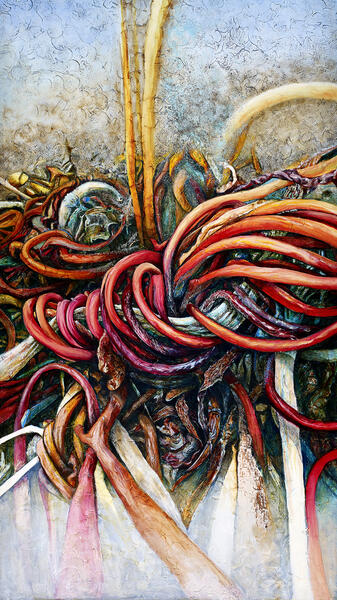 Pacific Kelp Tangle
Pacific Kelp TanglePacific Kelp Tangle, Oil on Linen, 62" x 36"
The health of the ocean’s kelp indicates the well-being of the oceans and sea creatures. I was surprised to learn that the kelp that washes up on the beaches of San Francisco changes color, depending on the seasons
-
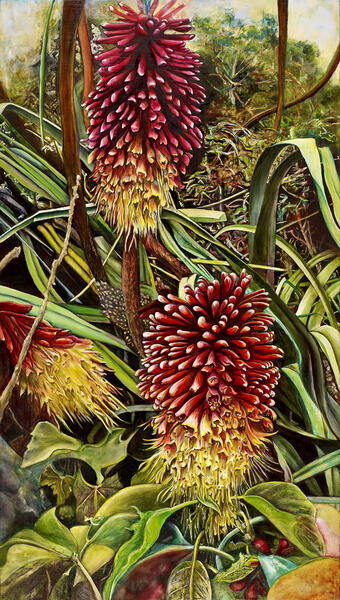 Kiwi Kniphofia
Kiwi KniphofiaKiwi Kniphofia, Oil on Linen, (62" x 36")
Viewed from up close and from far away, the Kniphofia (Red hot poker plant) revealed the passage of time as it decayed from bottom to top in my garden.
-
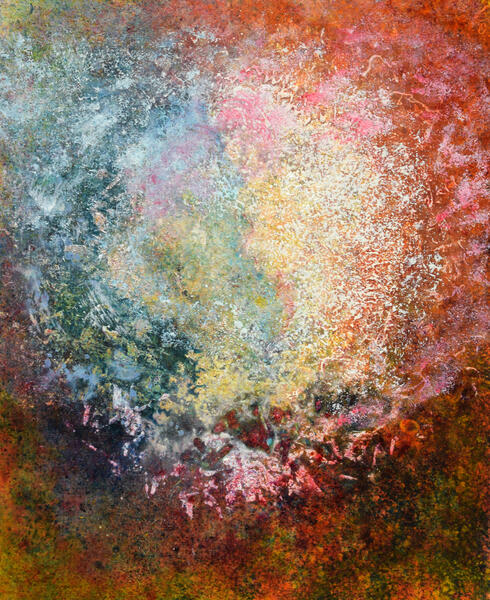 Dark Side Day
Dark Side DayDark Side Day, Oil on canvas, (20" x 16")
-
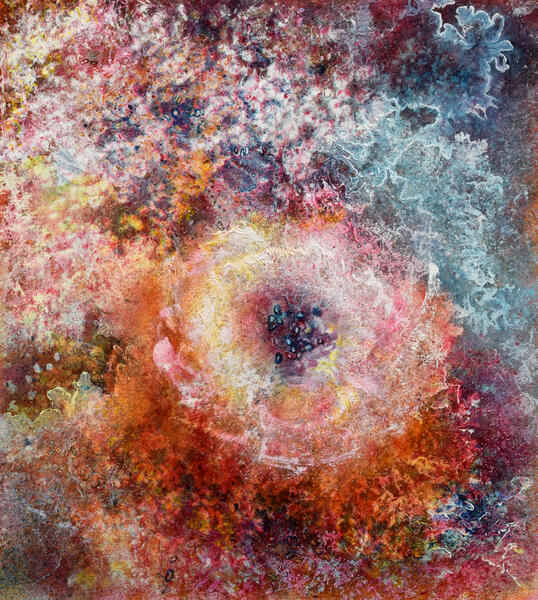 Capillaries and Craters
Capillaries and CratersCapillaries and Craters, Oil paint on canvas (36” x 34”)
Some of the components I use for textural effects are rock salt, sand, silica desiccant, iron oxide, calcium chloride from ice melt, sodium bicarbonate, iron oxide, water droplets, beans, seeds, rice, shredded paper, string, and stones.
SO IMPOTENT OUR WISDOM: SURPRISED BY SEEDS
A scientific study of the structure of plants and seeds led me to this series. I kept wanting to look closer and closer, as if nature’s secrets and mysteries might reveal themselves, if only I could get in close enough. To that end I used watchmaker’s lenses to study the complex anatomy of seeds and plants. A poem by Emily Dickinson was the source of my latest exhibition at the Adkins Arboretum:
“Nature is what we know -
Yet have no art to say -
So impotent Our Wisdom is
To her Simplicity.”
-
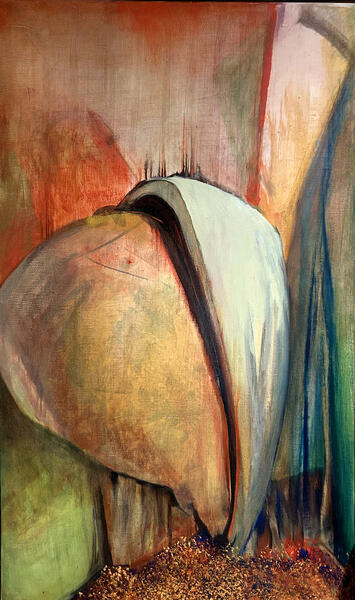 Alien Seed Pod
Alien Seed PodAlien Seed Pod, Oil on canvas, (36" x 22")
-
 Magnolia Pod Magnified
Magnolia Pod MagnifiedMagnolia Pod Magnified, Oil paint on linen on panel, (14" x 14")
-
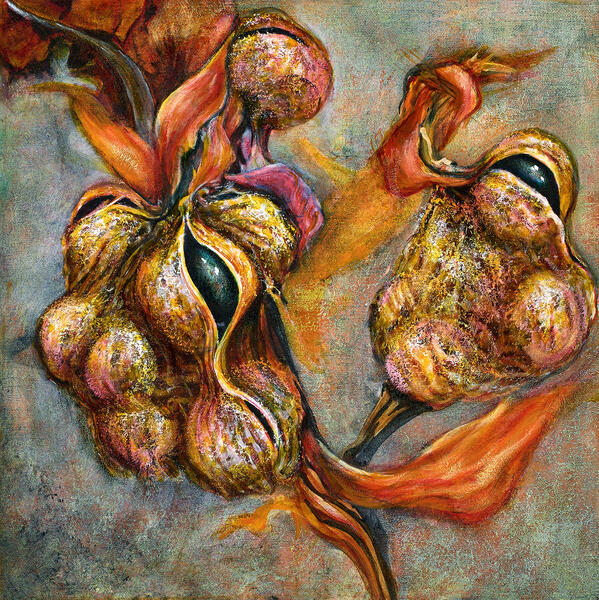 Canna Seed Baskets Magnified
Canna Seed Baskets MagnifiedCanna Seed Baskets Magnified, Oil paint on linen on panel, (14" x 14")
-
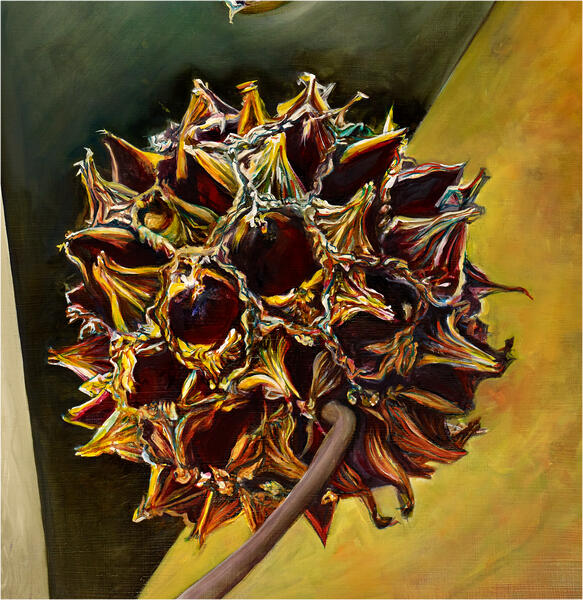 Sweetgum Ball Surprise
Sweetgum Ball SurpriseSweetgum Ball Surprise, (62” x 36”) Oil on Linen, (detail)
The very annoying — and painful to step on — ball from the sweetgum tree is pictured here. While observing and waiting for a green Sweetgum ball to open, I received a surprise one day in the studio. The individual sections opened, revealing hundreds of tiny feather-shaped seeds, along with their own fertilizer in the pod.
-
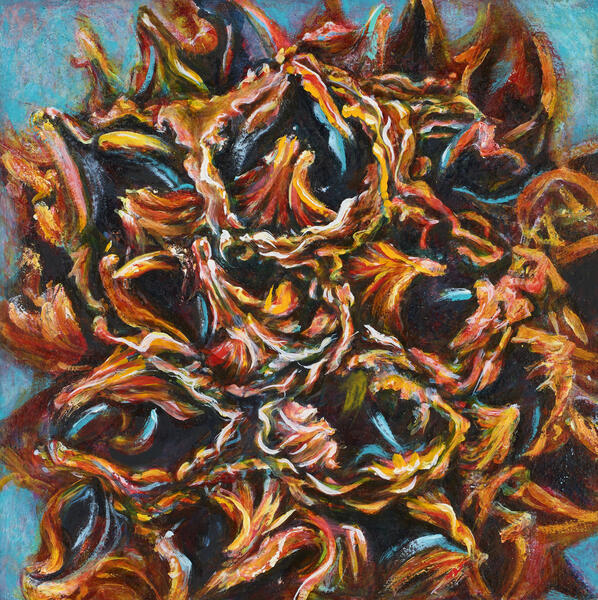 Sweetgum Ball Magnify
Sweetgum Ball MagnifySweetgum Ball Painting
Oil on linen on panel, (12" x 12")
-
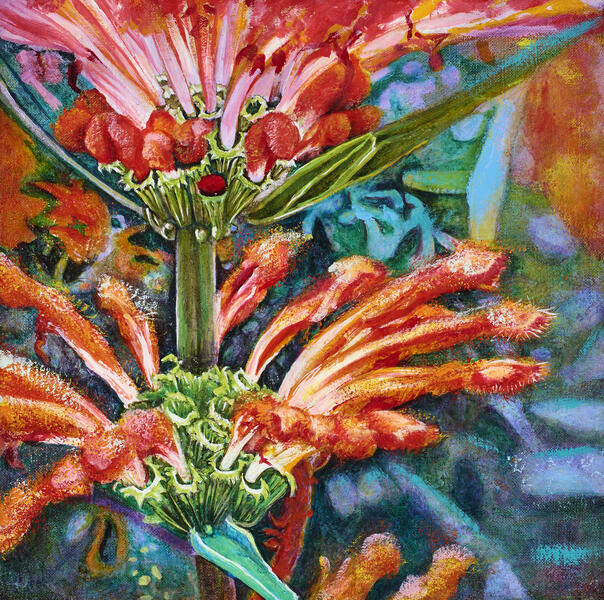 Lion's Tail
Lion's TailLion's Tail, Oil paint on linen on panel (14" x 14")
-
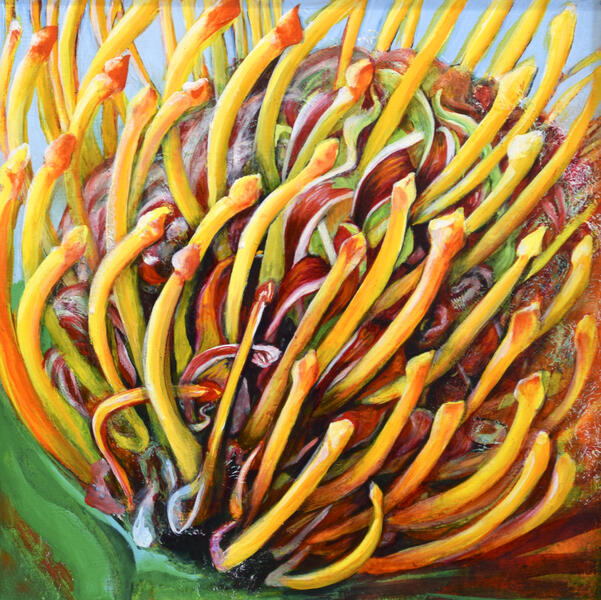 Protea Pins Magnified
Protea Pins MagnifiedProtea Pins Magnified, Oil paint on linen on panel, (14" x 14")
-
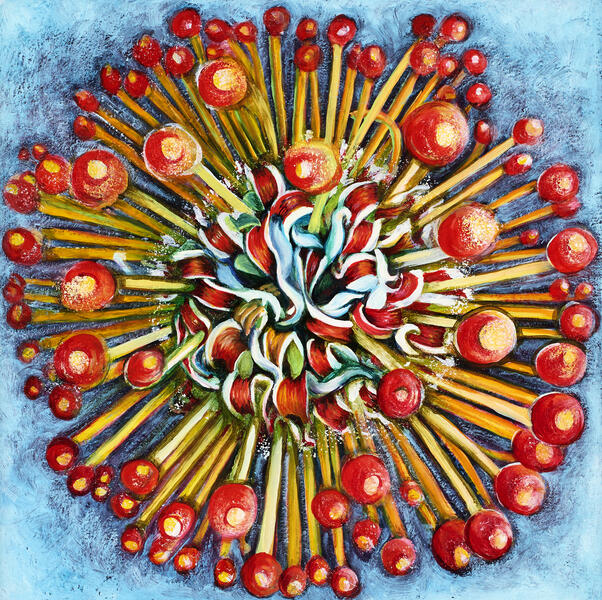 Protea Pins
Protea PinsProtea Pins, Oil paint on linen on panel, (14" x 14")
-
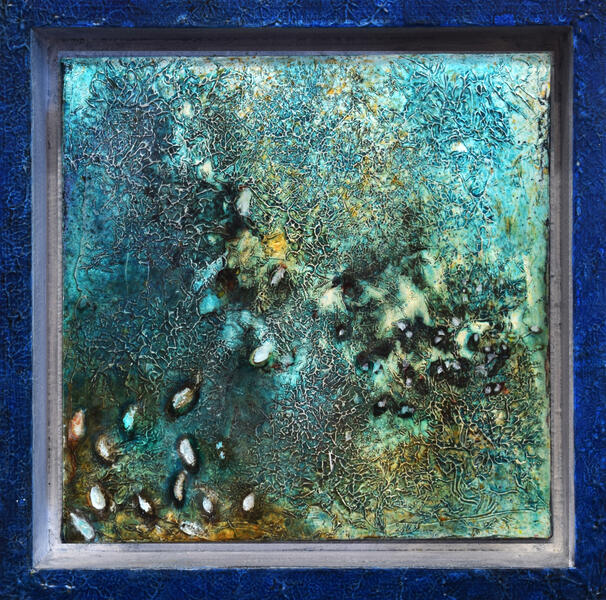 Seedscape
SeedscapeSeedscape, Oil on linen on panel in box, (12" x 12")
-
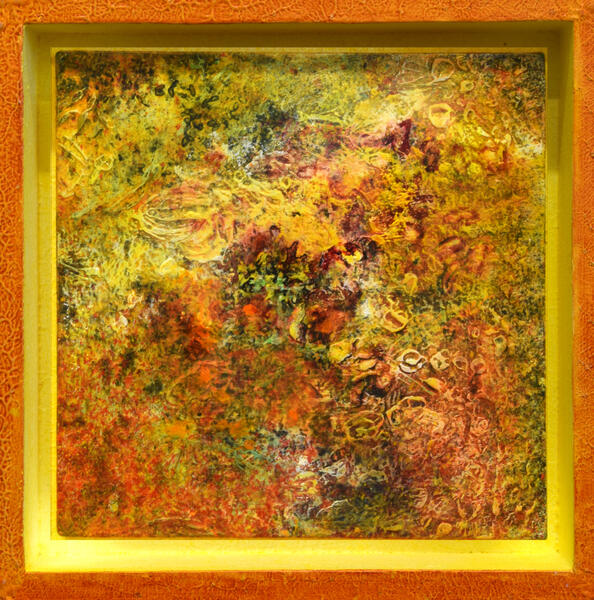 Roil
RoilRoil, Oil on linen on panel in box, (12" x 12")
ACTIVE STILL LIFE (NOISY SE-BUTSU)
Active Still Life: Noisy Se Butsu
These photographs were completed while attending a summer residency at the Kansas City Art Institute. The works on paper are inspirations for my paintings and convey the Active Still Life:
Many academic artists work from arbitrary objects, which they place on a table, in order to observe the effects of light, shadow, form, and color. In English, we call this collection of objects a “Still Life.” In French it is called “Nature Morte.” An art student I met told me the Japanese translation for still life is “Se-Butsu,” which roughly means “quiet objects.” The somewhat oxymoronic nature of these terms intrigues me. I call my still life studies “Noisy Se-Butsu” because for me, the still life is active, the quiet objects are noisy, and dead nature still has life in it.
-
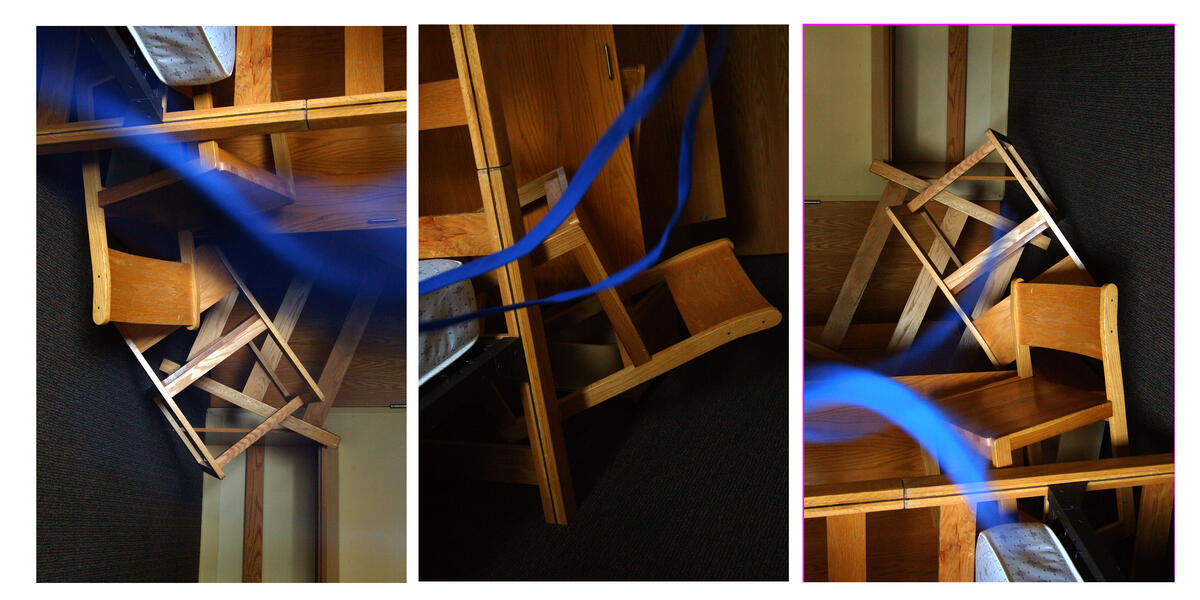 Three Chairs: Se Butsu"Three Chairs" is an archival Epson inkjet print in three panels, each is 28" x 16"
Three Chairs: Se Butsu"Three Chairs" is an archival Epson inkjet print in three panels, each is 28" x 16" -
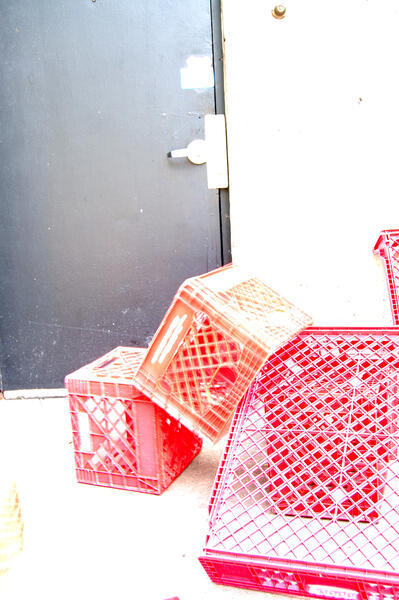 Tumbling Red Crates 2“Tumbling Crates” captures the point of perfectly balanced milk crates that were teetering of the edge of collapse. Adding one more crate to the stack resulted in its falling. I tried to capture the static balance and the tumbling movement at the same time. Balance is not static.
Tumbling Red Crates 2“Tumbling Crates” captures the point of perfectly balanced milk crates that were teetering of the edge of collapse. Adding one more crate to the stack resulted in its falling. I tried to capture the static balance and the tumbling movement at the same time. Balance is not static. -
 Tumbling Red Crates 1"Tumbling Red Crates" is a series of archival Epson inkjet prints. Measuring 28" x 16", the prints convey the "Active Still Life." I was interested in finding the point of perfectly balanced milk crates that were teetering of the edge of collapse. Adding one more crate to the stack resulted in its falling. I tried to capture the static balance and the tumbling movement at the same time.
Tumbling Red Crates 1"Tumbling Red Crates" is a series of archival Epson inkjet prints. Measuring 28" x 16", the prints convey the "Active Still Life." I was interested in finding the point of perfectly balanced milk crates that were teetering of the edge of collapse. Adding one more crate to the stack resulted in its falling. I tried to capture the static balance and the tumbling movement at the same time. -
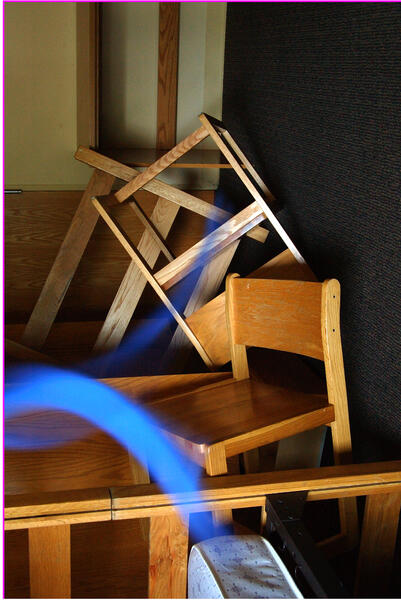 Three Chairs: Se Butsu (detail 3)"Three Chairs" is an archival Epson inkjet print in three panels, each is 28" x 16. “Nataraja’s Belt” - While driving down the highway, I noticed a moving truck that had two blue packing straps caught in the back doorway. As the truck drove along, the two blue straps were flapping in a frenzied dance together. I loved the movement they created, and tried to reproduce it by flipping two blue ribbons in front of the stacked dormitory furniture as I shot the photos.
Three Chairs: Se Butsu (detail 3)"Three Chairs" is an archival Epson inkjet print in three panels, each is 28" x 16. “Nataraja’s Belt” - While driving down the highway, I noticed a moving truck that had two blue packing straps caught in the back doorway. As the truck drove along, the two blue straps were flapping in a frenzied dance together. I loved the movement they created, and tried to reproduce it by flipping two blue ribbons in front of the stacked dormitory furniture as I shot the photos. -
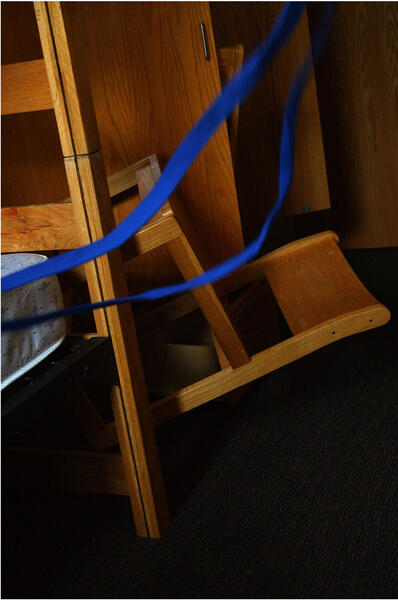 Three Chairs: Se Butsu (detail 2)"Three Chairs" is an archival Epson inkjet print in three panels, each is 28" x 16"
Three Chairs: Se Butsu (detail 2)"Three Chairs" is an archival Epson inkjet print in three panels, each is 28" x 16" -
 Three Chairs: Se Butsu (detail 1)"Three Chairs" is an archival Epson inkjet print in three panels, each is 28" x 16"
Three Chairs: Se Butsu (detail 1)"Three Chairs" is an archival Epson inkjet print in three panels, each is 28" x 16"
